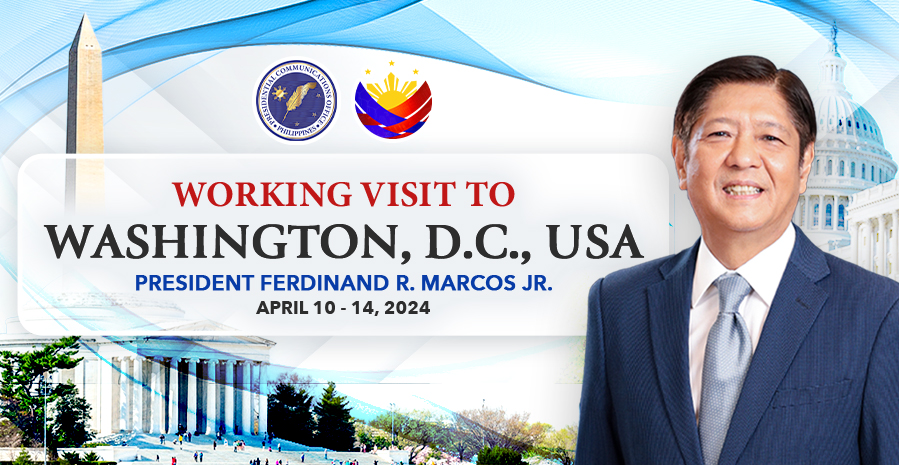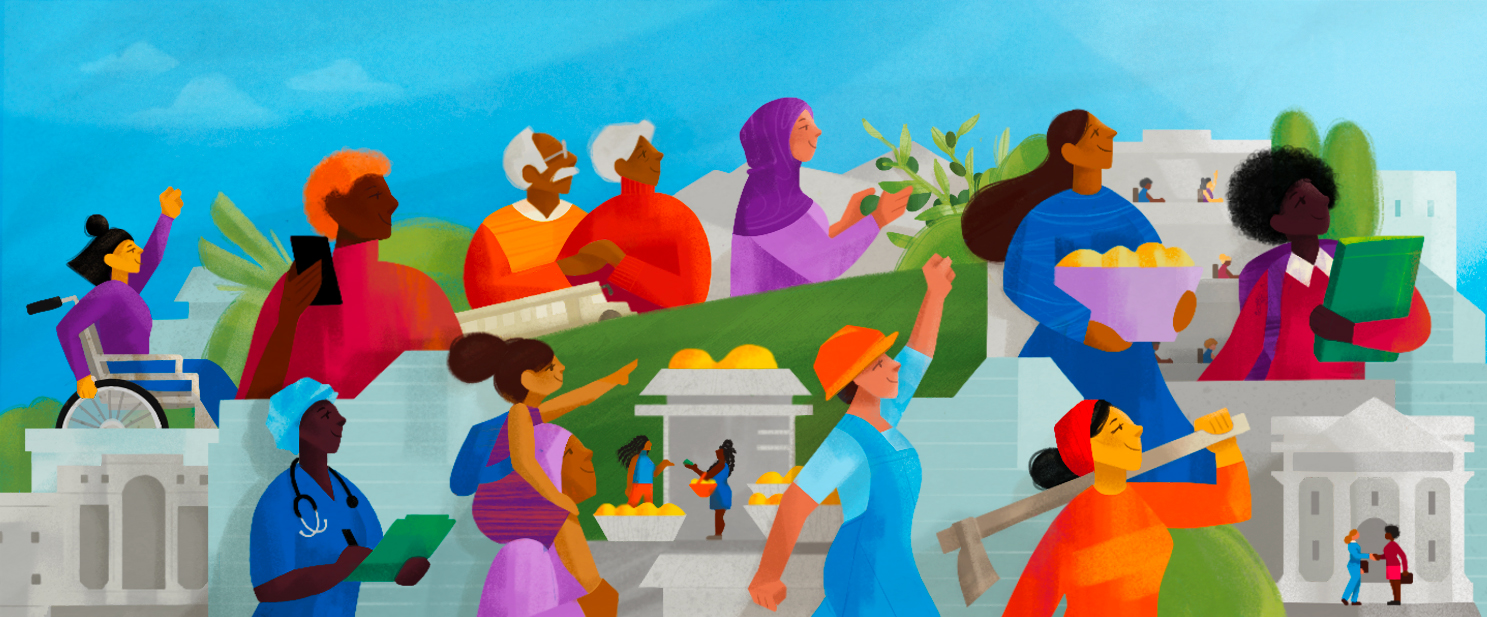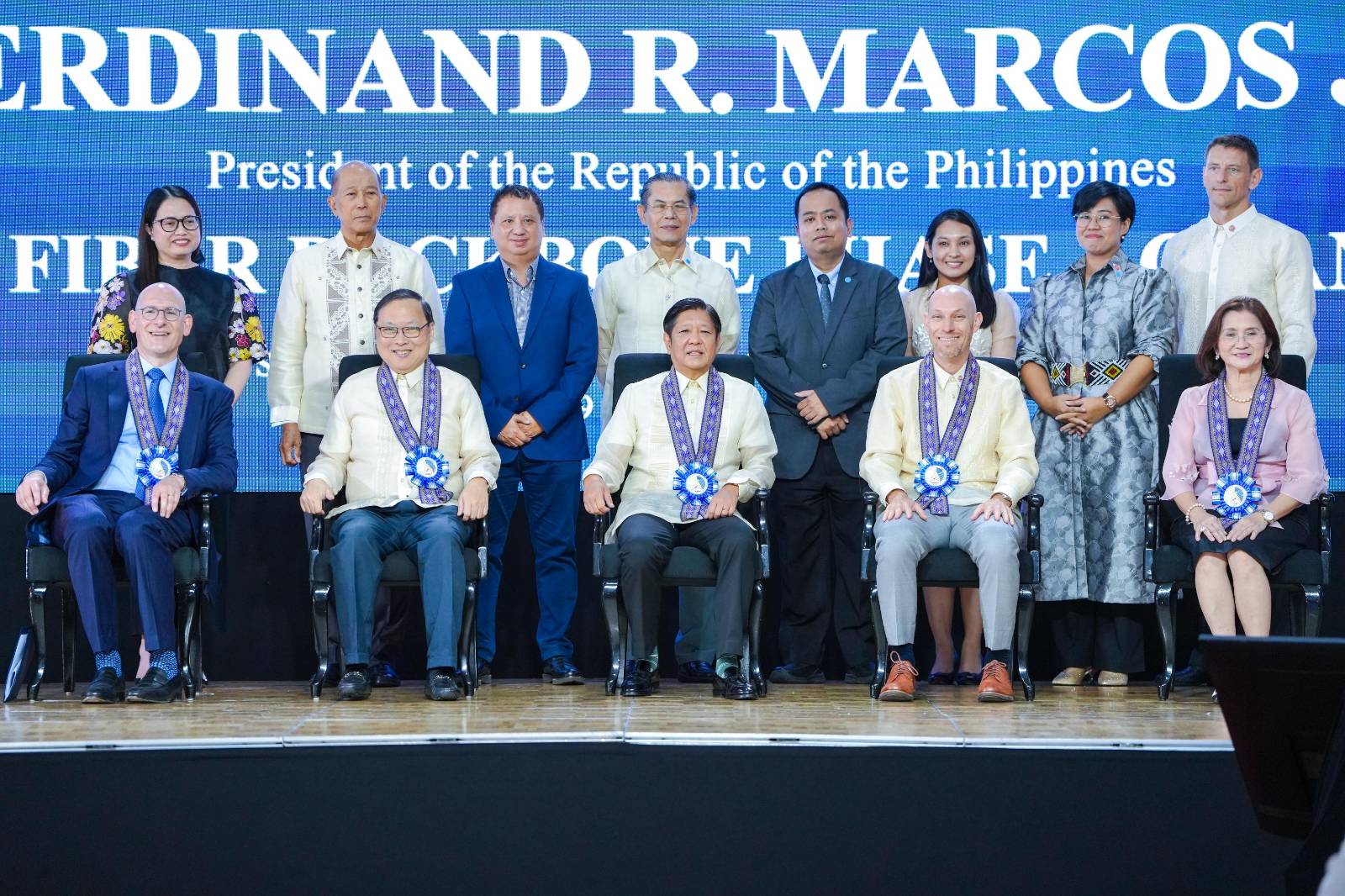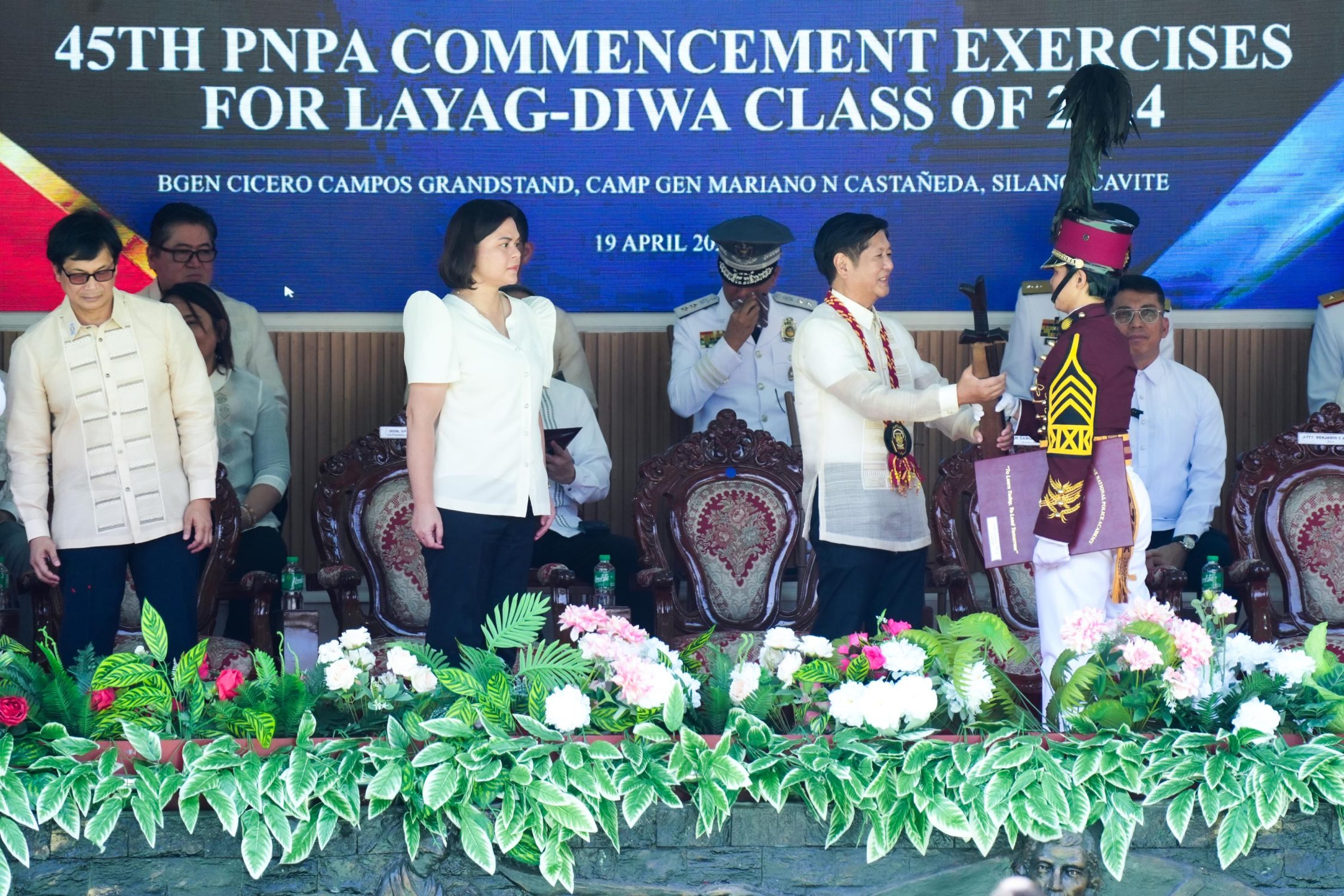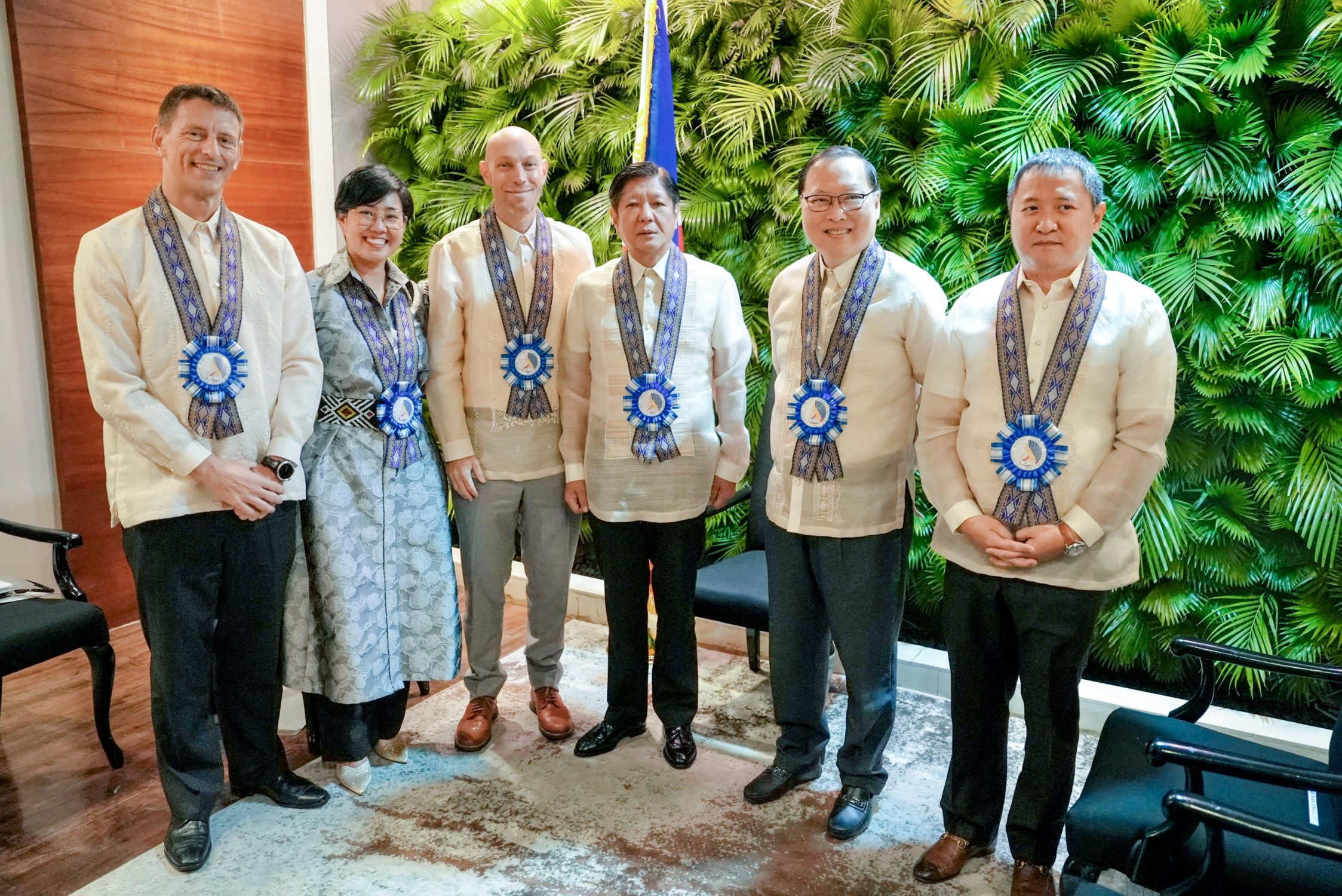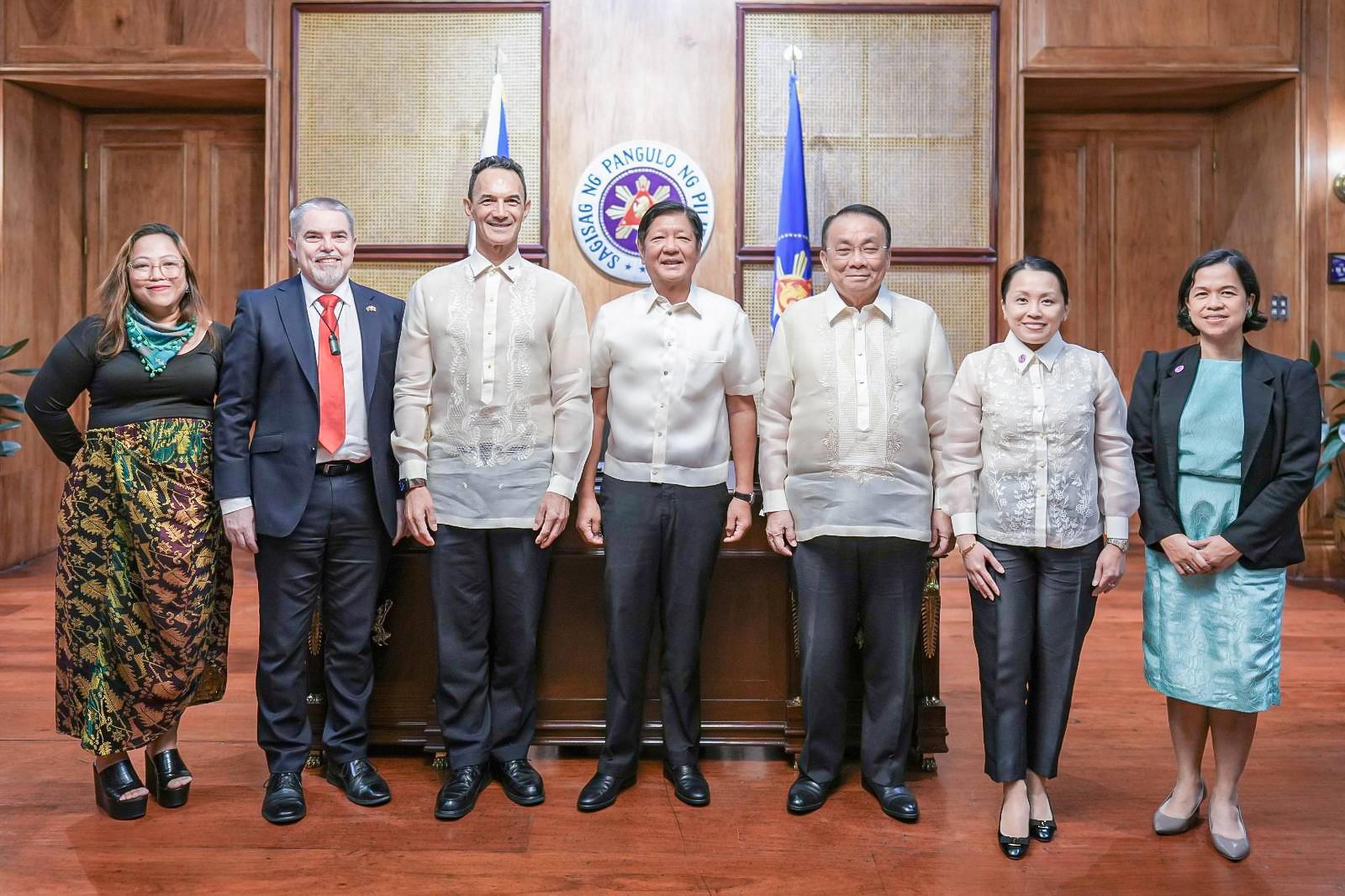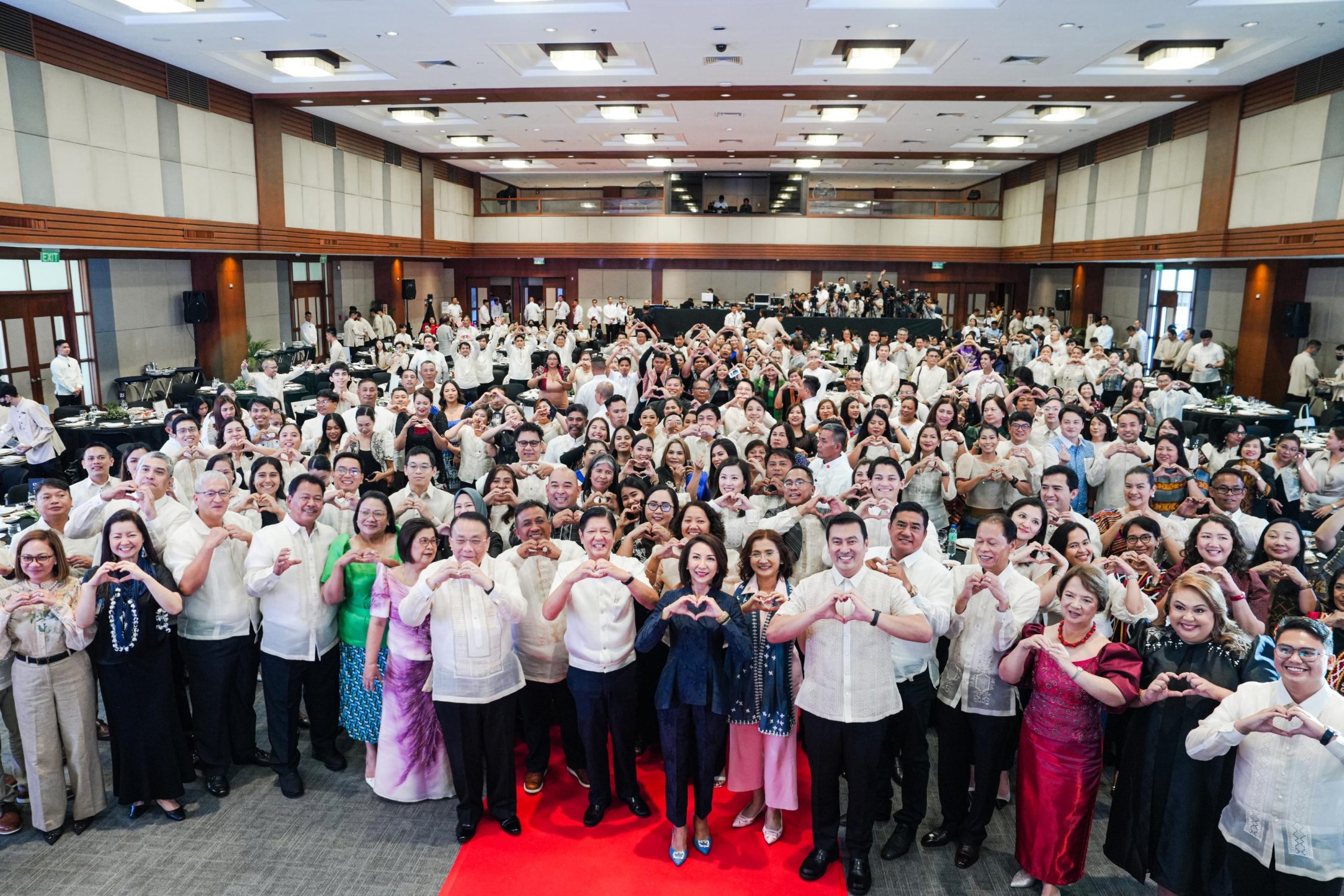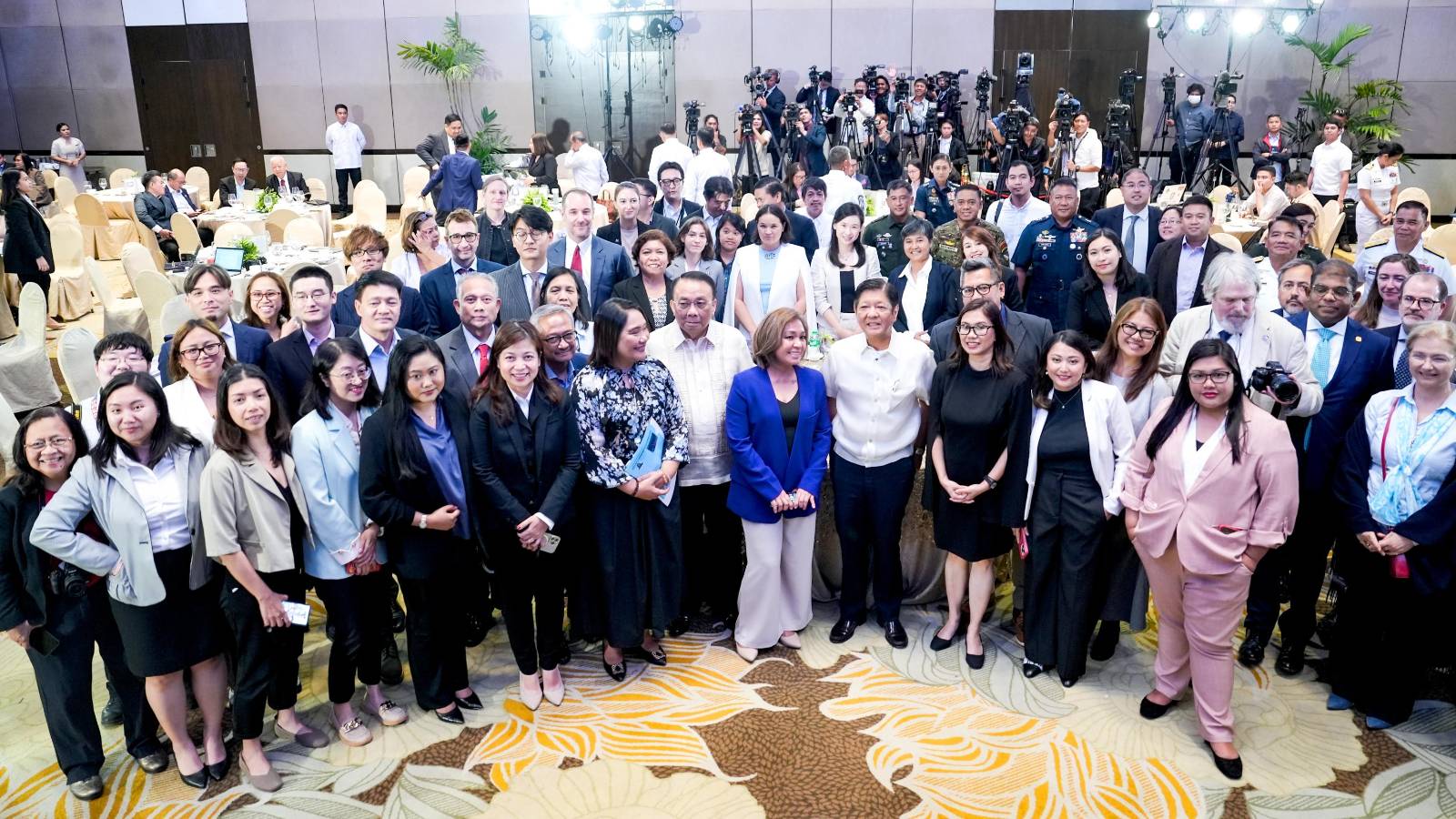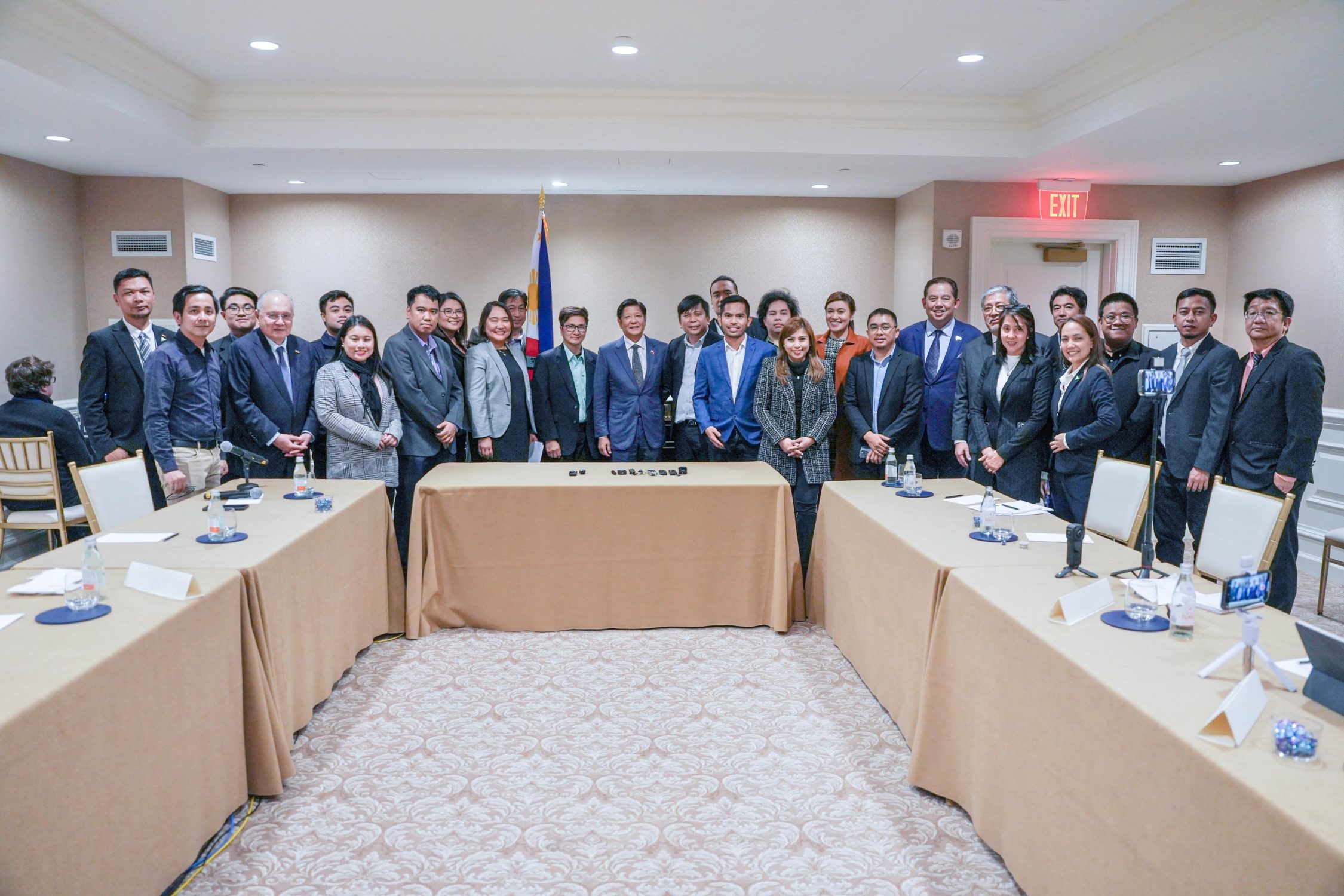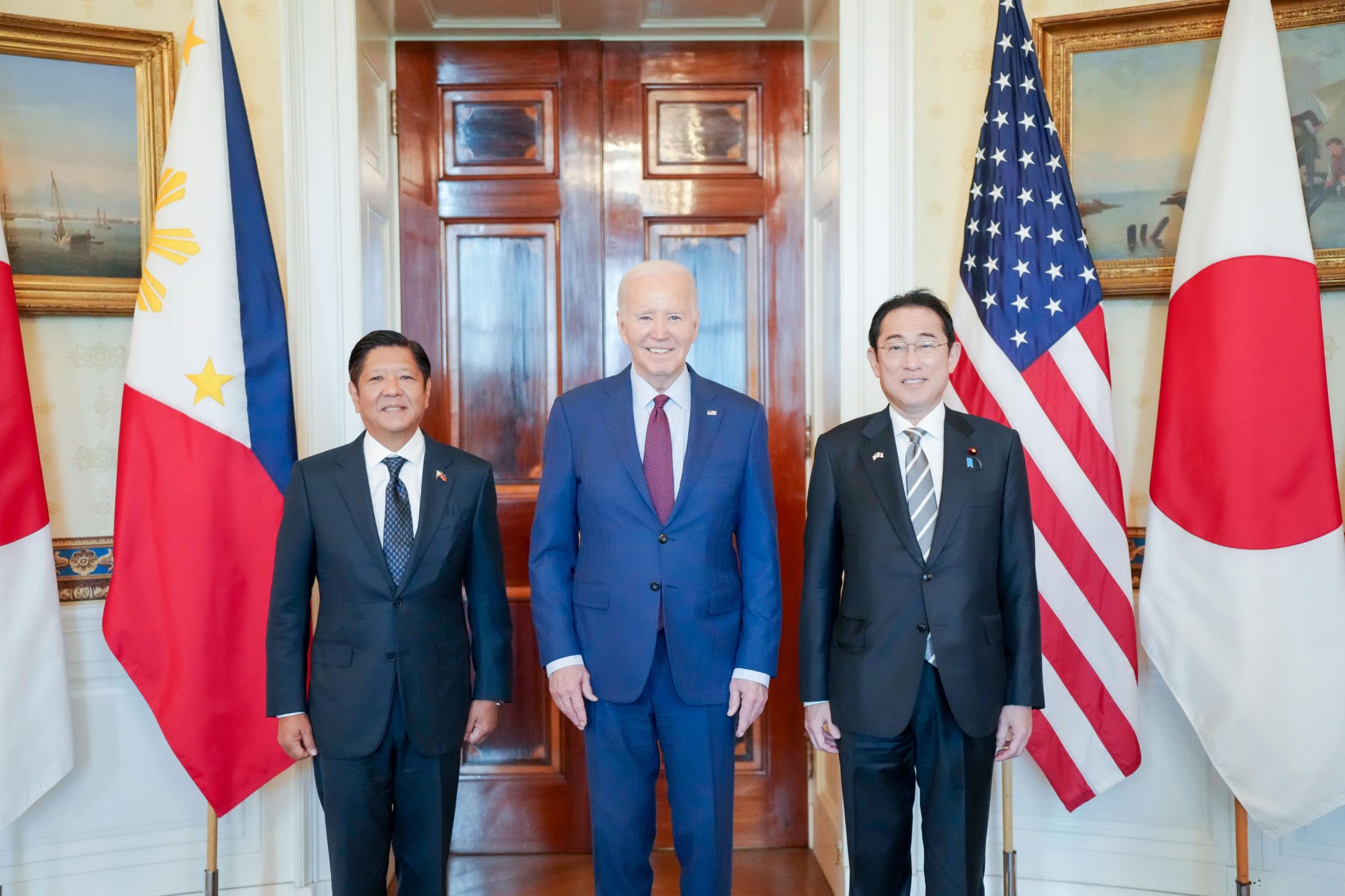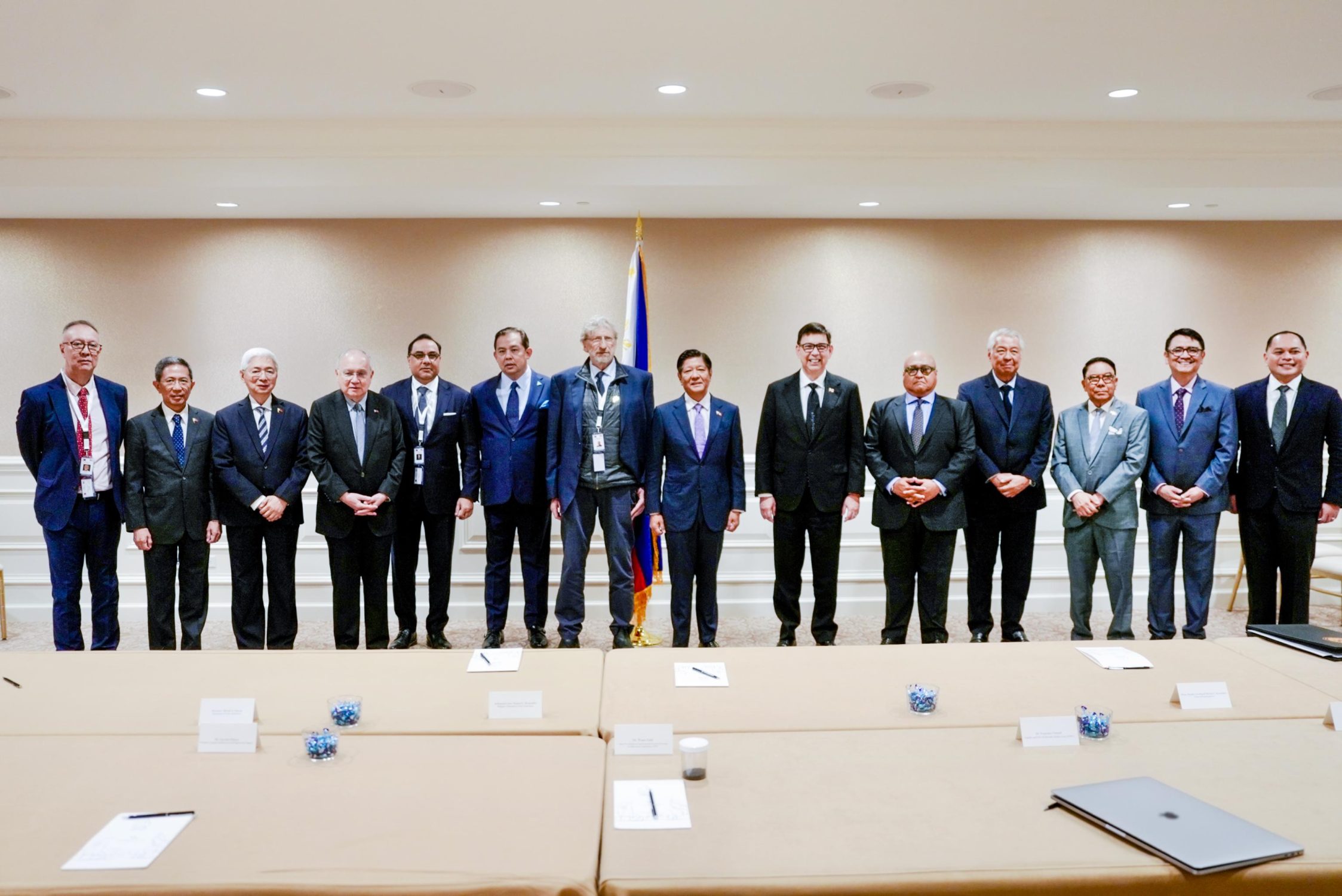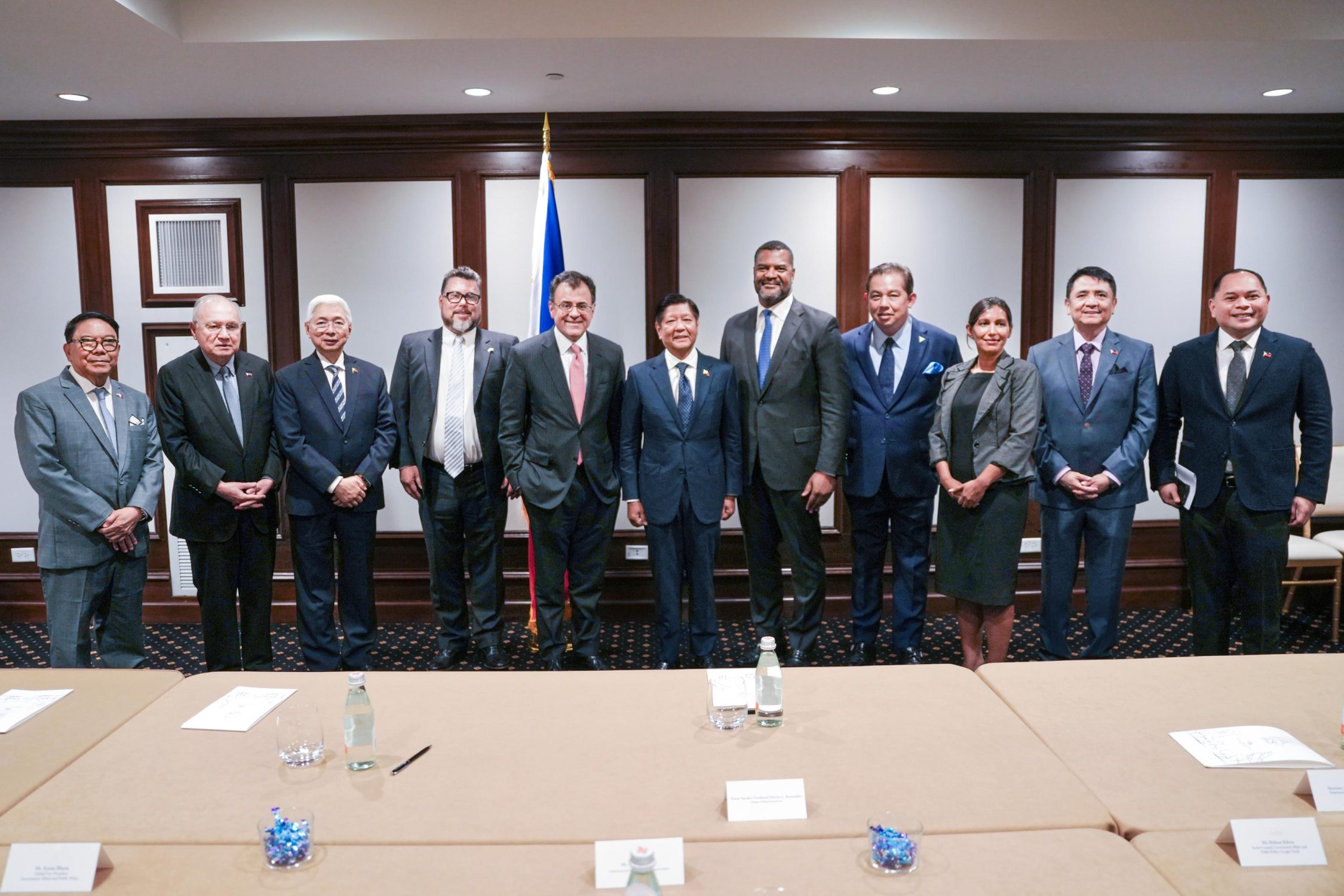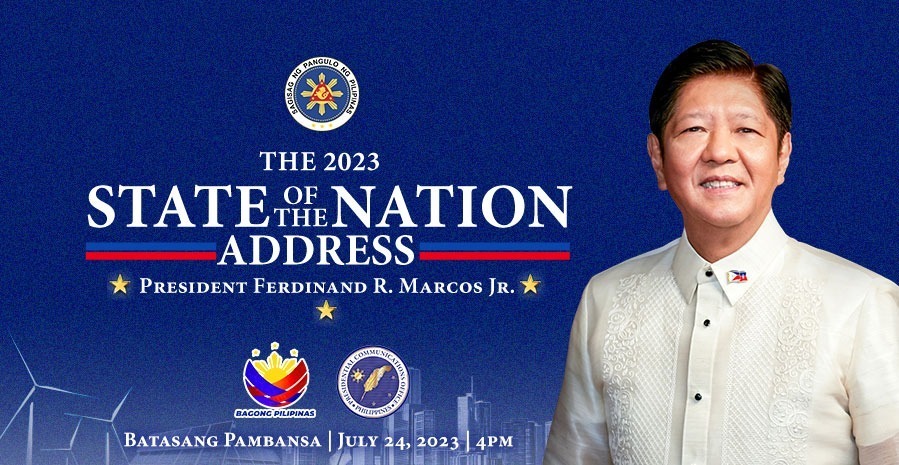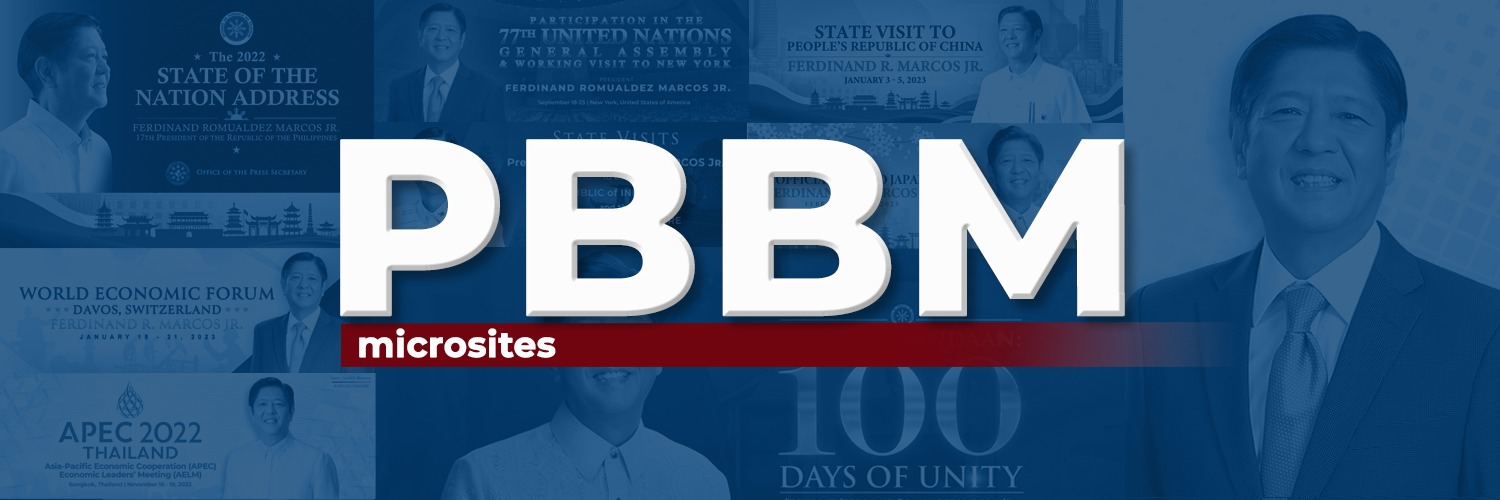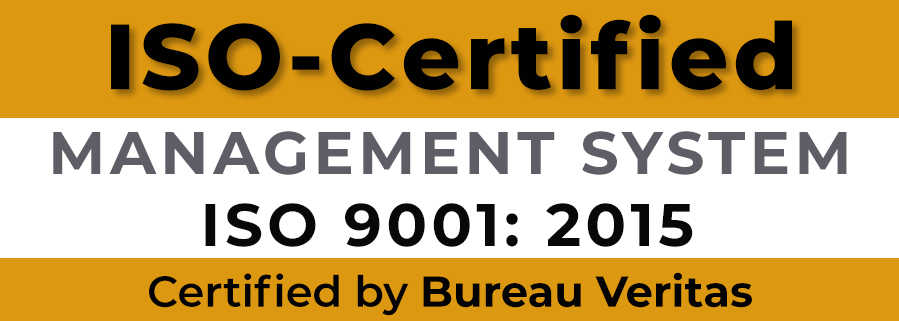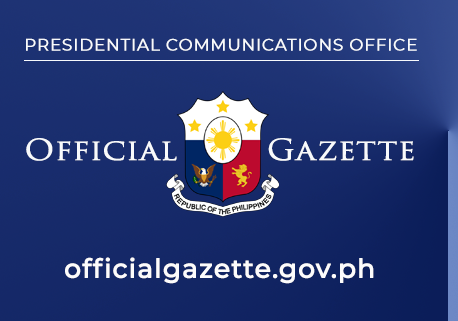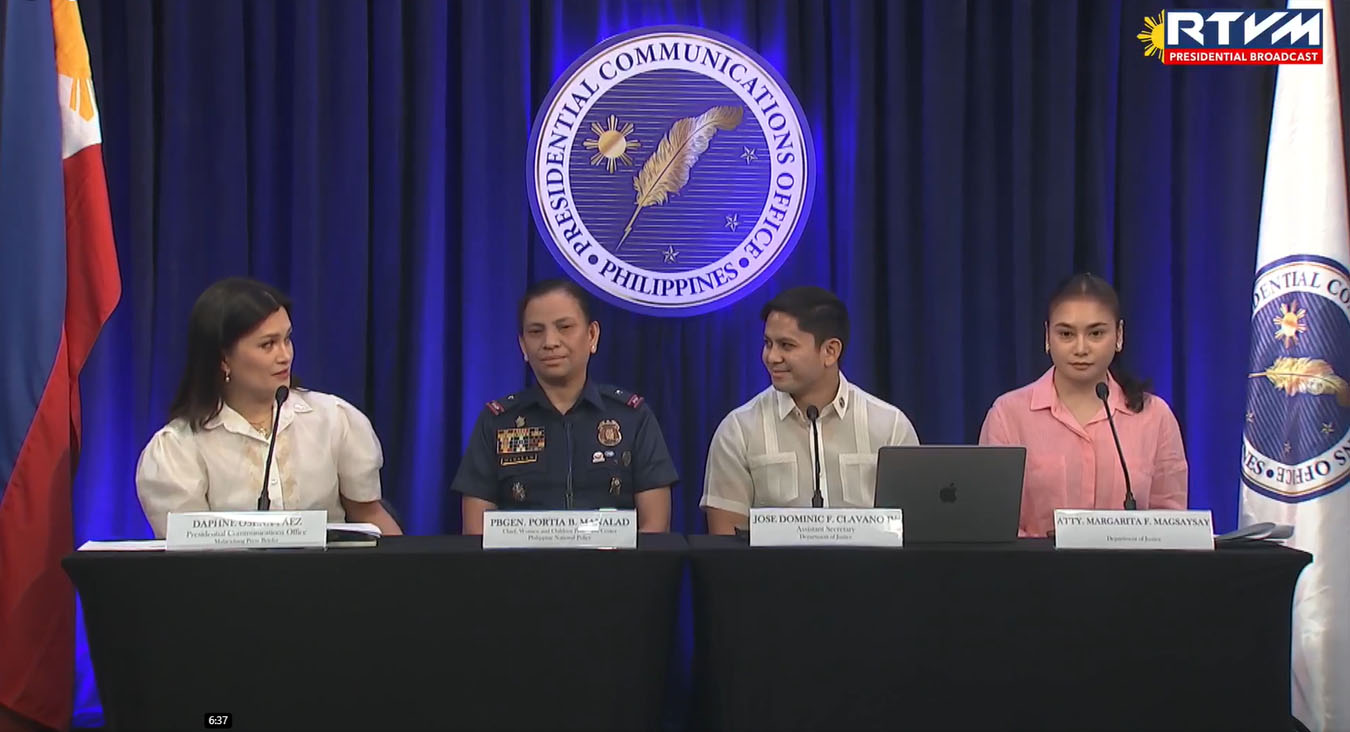Nov. 03, 2016 – Press Conference of Presidential Communications Secretary Martin Andanar with Department of Transportation (DOTR) Sec. Arthur Tugade; Department of Public Works and Highways (DPWH) Sec. Mark Villar; NEDA Director General Ernesto Pernia; and the Bases Conversion and Development Authority (BCDA) President and CEO Vivencio Dizon
| Press Conference of Presidential Communications Secretary Martin Andanar with Department of Transportation (DOTR) Sec. Arthur Tugade; Department of Public Works and Highways (DPWH) Sec. Mark Villar; NEDA Director General Ernesto Pernia; and the Bases Conversion and Development Authority (BCDA) President and CEO Vivencio Dizon |
| Press Briefing Room, New Executive Bldg., Malacañang |
| 03 November 2016 |
|
OPENING STATEMENTS: SEC. ANDANAR: Good morning, Rocky. Magandang umaga po sa inyong lahat at lahat ng nanunuod sa atin sa PTV at nakikinig sa Radyo ng Bayan at sa mga kababayan po natin sa iba’t ibang bansa na nanunuod sa pamamagitan ng ating Facebook page sa Presidential Communications. Ladies and gentlemen of the Malacañang Press Corps, we are fortunate to have four distinguished resource persons for today’s briefing and they shall talk about the Duterte administration’s infrastructure program. Our battle cry is build, build, build. And our speakers are as follows: NEDA Director General Ernesto Pernia, who is one of the President’s economic managers. Secretary Pernia is Professor Emeritus of Economics at the University of the Philippines and lead economist at the Asian Development Bank. Dr. Pernia was a visiting resource fellow at the East West Center Resource Systems Institute in Honolulu, USA and was regional adviser on population and employment policy for Asia and Pacific with the international labor organizations. This outstanding Boholano is once an Outstanding Young Scientist from the National Academy of Science and Technology. Still is. Still is, still is. Balik Scientist awardee of the Department of Science and Technology and currently ranked 7th among the 250 scientists in the Philippines, according to Google Scholar citations public profiles. Secretary Pernia’s areas of expertise on economic growth and poverty reduction, population and development augur well to the thrust of the Duterte administration to make socio-economic growth and development self-sustaining and inclusive for all Filipinos. We also have Secretary Arthur Tugade whose rags-to-riches success story seems one lifted from storybooks. Secretary Art grew up in the slums and worked his way to being a lawyer, a businessman, and a billionaire. A scholar of San Beda College from elementary to law school, cum laude and magna cum laude in Liberal Arts, Secretary Tugade believes in giving back and paying forward. In 2003, he founded Perry’s Group of Companies Corporation that is into trucking, logistics, shipping, fuel distribution, travel, and fashion. The site where he initially built his group of companies used to be a dumping ground of a computer company but used it as start-up site for his early 11 – note, 11 companies. Prior to his entrepreneurial success, Secretary Tugade held several executive positions in various private companies. He started as an Executive Assistant of the Delgado family’s Transnational Diversified Group Inc. in 1973 and climbed up the ladder to become President and Chief Operating Officer. In 2012, Secretary Tugade was appointed President and Chief Executive Officer of the Clark Development Corporation. Under his leadership, CDC reported a record-breaking 1.49 billion pesos or 32 million dollars worth of revenues from 2013 to 2015. During his watch, CDC became the Company of the Year in Asia CEO Forum. We also have with us Secretary Mark Aguilar Villar of the Department of Public Works and Highways, DPWH. Prior to his appointment to President Duterte’s Cabinet, Secretary Villar served as Representative of the Lone District of Las Piñas City during the 15th and 16th Congress where he authored more than 100 bills and close to 90 resolutions. He was the General Manager of Crown Asia Corporation from 2002 to 2010 before his foray into politics. Secretary Villar finished his MBA at the University of Chicago Booth School of Business and Bachelor’s degree in Political Science at the University of Pennsylvania. A musician, Secretary Villar plays the saxophone. Parang Bill Clinton lang ang peg. And lastly, the most famous of them all is the President and Chief Executive Officer of the Bases Conversion Development Authority or BCDA, Vivencio “Vince” Dizon. Vivencio pala ha. BCDA President Dizon served the government in various capacities. He was Undersecretary for Political Affairs of the Office of the President, a Chief of Staff to Senator Edgardo Angara, Consultant to Senator Alan Peter Cayetano. Mr. Dizon finished a Master of Science in Applied Development Studies in the University of Reading, United Kingdom as a Chevening Scholar and a Bachelor of Arts Degree in Economics and Bachelor of Science Degree in Management and Financial Institutions at the De La Salle University where he later taught as an Assistant Professor of Economics. Ladies and gentlemen of the Malacañang Press Corps, let us all give a warm of applause and welcome to our four distinguished guests. SEC. TUGADE: Magandang umaga ho sa inyong lahat. Nagbibigay pugay kami sa Malacañang Press Corps. We thank you for the opportunity for us to be able to dialogue and communicate with you regarding certain projects in government. Napakaganda ho itong pagkakataon na ito, pagka’t ngayong panahon na ito, ngayong araw na ‘to, mapapakinggan ninyo ‘yung mga samu’t saring mga proyekto ng ating adminstrasyon na gustong gawin at gampanan. Magbibigay din ho tayo ng pagkakataon na maipaliwanag sa inyo ‘yung mga iba-ibang proyekto. Marahil nagtataka kayo na bakit apat na Cabinete nandidito ngayon, na kung saan ‘nong nakaraan, tama na ‘yung isang Cabinet member, paminsan-minsan dalawa. Ngayon apat. Sinadya po namin na umupo at maki-usap sa inyo ngayon na apat kami upang ipakita sa inyo ‘yung tinatawag na coordination and solidarity ng mga Cabinete sa mga bagay-bagay na meron silang koordinasyon at kinakailangan lang na magkaroon ng koordinasyon. Nakikita niyo na nagsasama ngayon. Isang halimbawa, ang Department of Public Works at ‘yung Department of Transportation na pinangingibawan ng ating Director ng NEDA. Noon ho, minsan ang takbo ng isang departamento, pakaliwa. Paminsan-minsan habang tumatakbo ‘yung pakaliwa, pumupunta naman sa pakanan. Ngayon, sinasabi namin, magsama-sama tayong maglakad, hindi lang maglakad, tumakbo, hindi lang tumakbo, lumipad. Kaya ngayong araw na ‘to, sama-sama kami na nandidito. Nandidito ho ‘yung BCDA because ang BCDA ay isang government corporation na kung saan nag-uunday at kung saan nagtatanim ng mga butil ng mga proyekto at investment upang magampanan ang paglago ng ating pamahalaan. Makikita niyo sa aming presentasyon na ‘yung pagsama-sama namin dito ay may kahulugan. May ibig sabihin na koordinasyon. So kaya nga ho ngayon araw na ‘to, kayo sa Malacañang Press Corps, binibigyan namin kayo ng hindi isang Cabinete, hindi dalawang Cabinete, tatlong Cabinet members at isang BCDA GCG. In other words, this is our expression of solidarity and coordination with the government of President Duterte. Noong nakaraang eleksyon ho na pangako ng ating Pangulo, na sosulusyunan niya at ititigil ‘yung tinatawag na problema sa droga at korapsyon. Ngayon ho, ngayon araw na ‘to, ay tutumbukin natin at bibigyang pananaw at pansin ang isang bagay na napangako ng ating Pangulo ‘nong eleksyon. Ang sabi niya, bigyan natin ng solusyon ‘yung problema ng ating mga kababayan. Problema, kulang sa trabaho. Problema, mataas na presyo. Problema, transportasyon at trafiko. Ang sabi namin, kaming apat na ito, ‘yung sabi rin ng ating Pangulo, solusyunan natin ‘yan sa tinatawag na imprastruktura. Kaya nga ba’t sinabi ni Secretary Andanar kanina, our battle cry is build, build, build. Build infrastructure. Bakit magpapatayo tayo ng mga imprastraktura? Dahil ho ito ho ang isang solusyon upang matugunan ang pangako ng ating Pangulo na si Presidente Duterte na dapat solusyunan, hanapan ng solusyon ‘yung tinatawag na kakulangan sa trabaho, ‘yung matataas na presyo, ‘yung pawis at kabwisitan ng transportasyon at trapiko. Build, build, build infrastructure because we have to build infrastructure because common sense will tell you that it is the infrastructure that will do the connectivity and mobility. Connectivity amongst LGUs. Connectivity amongst places and mobility from one place to another. Pagka’t kung magkakaroon ka ng connectivity at mobility, hindi ho no brainer ‘yan. ‘Yan ho ay no brainer pagka’t ang connectivity at mobility will spell and will serve as the ground fundamentals for you to develop and grow. Kaya nga ho sinasabi namin, build infrastructure. Liliwanagin ko lang ho. ‘Yung makikita at mapapakinggan niyo ngayon ay hindi kabuuan ng lahat ng imprastraktura na gustong gawin ng ating Pangulong Presidente Duterte. Itong mga imprastraktura na makikita niyo at i-eexplain namin sa inyo kumbaga ang tawag diyan, patikim lamang. Patikim lamang. At sinasabi naming, itong mga imprastraktura na dapat gawin sa pamahalaan ng ating Pangulo ay dapat matapos within reasonable terms and within economic reasons during the five, six years term of the President. Five years na lang kasi natapos na ‘yung apat na limang buwan. Ito ho ‘yung timetable niyan, ipapakita ho ng ating kasamang si Vince mamaya ‘yung timetable. So ang usapan ho ngayon, solusyon. Ang usapan ho ngayon, imprastraktura. Ibig bang sabihin, lahat ‘yan? Hindi ho. Ito ho patikim lang ng mga proyekto upang makikita ninyo na hindi lang direksyon para sa droga at korapsyon. Hindi lang direksyon sa trapiko at transportasyon kung hindi pangkalahatan ekonomiya. Na kung saan mababahagi at magiging pundasyon ng development ang growth, ang mga imprastrakturang aming ipapakita at i-eexplain sa inyo. SEC. PERNIA: Excuse me. Mag-ingles na ako kasi hindi kayo marunong mag-Bisaya eh. Baluktot kasi ang Tagalog ko. So as Secretary Tugade has said, infrastructure is the basic ingredient, the underpinning of any development activity, and any building of the economy, it has to start with infrastructure, and mobility is very important these days. Not only mobility through connectivity sa ICT but also physical mobility and that is what… physical mobility is what we’re going to facilitate or make easier under this infrastructure projects that we are going to show you. Okay, actually hindi lang namin pinapakita ang mga imprastruktura. Gusto rin namin ipalaman sa inyo na mabilis kami mag-aksyon. Okay. In a matter of one month and two days, we were able to convene the Investment Coordinating Committee, August 2nd and decide on nine infrastructure projects at the time. These nine infrastructure projects, which by now I think are known to you. SEC. PERNIA: These nine infrastructure projects which by now I think are known to you have already passed the NEDA board, the NEDA board which is chaired by the President and that is the final hurdle of projects before they get implemented by the concerned agencies like Department of Transportation or Department of Public Works and Highways, Department of Health, Department of Education and so on. These are the implementing agencies. The NEDA Board is the one that approves these projects, as I’ve said chaired by the President. And these nine projects have already gone through that channel or that “eye of a needle”. Because if you recall, in the previous administration, only 12 projects—infrastructure projects were passed by the previous administration in a matter…in over…in a period of six years. Now, as I’ve said, in a matter of two months we’re able to, because the nine projects after 40 days, we got it approved through…from ICC to NEDA Board approval we got it approved by the NEDA board so they are now being implemented. To get the projects implemented they have to be, there has to be some procurement activity as well as bidding –and those projects are now in the stage of bidding before awarding and construction—actual construction. And during the period of construction, of course many jobs are created. And because we are going to do these infrastructure projects in a regimen… work regimen of 24/7 maraming employment, maraming jobs ma-generate kasi three shifts na ‘yun eh and more over, instead of for example, finishing a project in three years, it can be done in one year if we really do them 24/7. Then the other thing that…well that was September 14 was the approval of the nine projects by the NEDA board. This afternoon or this evening if the President…if time allows, we’re going to have a NEDA Board meeting again to get seven more projects approved by the NEDA board so that they can be implemented thereafter and these have to do with agriculture projects: one in Cordillera, two in Mindanao. The other projects are the South Line, South Line Rail Project which goes from Manila to… no, no. It goes from Manila to…no, no, it goes to Sorsogon, to the end of the Bicol Region. And that will be around 600 kilometers and the cost of that project is in the order of 200 billion, that railway project. So, again another project that tries to disperse the congestion that we have in Metro Manila, to disperse development, to improve mobility so that development can be dispersed to the regions. The other projects have to do with widening of the road from Tutuban to Valenzuela which is about nine kilometers and I understand now, it’s really a cause of bottlenecks because there is only one lane each way and you know, when jeepneys stop on the road then you know, traffic builds up very quickly and so this widening project will make the two-lane on each way, sorry—the one lane on each way to two lanes. In other words the road will become a four-lane road. And another project we’ll have to do another, will be another road improvement project somewhere from Valenzuela also to connect with Quezon City. Another project that’s going to decongest traffic in that area. So that going to the north, apart from using the—well, going to the NLEX can already be accessed through these improved roads which we hope can be done in nine years. I’m sorry, in three years—in three years, okay. So those are the seven projects. Those are among the seven projects that we are going to submit to the NEDA Board perhaps tonight or… and they are…Malacañang also said that if not tonight, then in the December Cabinet meeting cum NEDA Board meeting. So all these infrastructure projects will require ramping up the spending on infrastructure from four…I think 4.5% previous year last year…two to three percent last year, we’ll wrap it up to 5% …5.4 this year and moving forward, we’ll keep it at least at 5 percent of GDP and it will likely go up higher to 7 percent till the end of the Duterte administration. So that’s going to be, as Secretary Diokno would say, this Duterte administration will be a Golden Age for Infrastructure, building them 24/7. Okay, and the thing is we really have to catch up with our neighbors. We have been lagging behind our ASEAN neighbors even Asian neighbors as well and so the infrastructure deficit is so huge that we really have to double time, triple time to even approach the, at parity with the infrastructure level of our neighbors in Asia. SEC. VILLAR: Magandang tanghali po at sinabi po ng ating Pangulo na gusto niya na magkaroon po tayo ng “Golden Age of Infrastructure.” Kaya over the past administrations, ang range po ng spending natin sa infrastructure related to GDP has been 2 to 3 percent. During the first year of President Duterte, magiging 5.4 percent, almost double—more than double the average spending under previous administrations, 5.4 percent of our GDP. Sa Asya po, ang ating mga developing countries katulad po ng India at ng China ay gumagastos po ng 8 to 10 percent ng GDP nila sa infrastructure. So at minimum, we want to maintain this 5 percent but we’re also targeting to reach as high as 7, minimum 7 percent spending over the next few years. This is to catch up para makahabol din tayo sa ating mga neighbors dito sa Asya. So makikita niyo po sa next slide, ito po ‘yung aside from more railways, where will we spend this infrastructure? More railways, urban transport, airports, seaports, roads and bridges and new and better cities. We’re planning to create new hubs that will attract the congestion from Metro Manila and bring development to our rural—the countryside. And yun lang po…yun ang objective ng ating Presidente na umabot sa rural communities ang development. And on our part, the President ordered us to work 24/7 and that’s exactly what we’re going to do. We’re united here to show you that this whole government is dedicated to just doing it, just working 24/7 to reach these goals in infrastructure. Over the past few administrations, I think there’s been less of a focus but under the Duterte administration, this will be one of the primary focuses of this ad—of this government. Kagaya ng sinabi po nila, “Build, build, build.” So I’d like to show you a taste of some of the projects that we have already, we will already start on the part of the DP—mamaya po ipe-present din po ni Secretary Tugade ‘yung mga projects nila sa DOTr. In terms of the DPWH, I’d like to show you some of the highlights of our infrastructure program. Ito po, “Santa Monica-Lawton-BGC Bridge.” This is a project that will start next year and this is a project that once completed, will reduce the traffic—will redirect, reduce the traffic in EDSA and C5 by 35 percent. Makikita niyo mabawasan po ang numbers, ang vehicular traffic by 100,000. Ito pong bridge ay from The Fort—ay magsisimula po sa Fort and it will end in Ortigas. So para sa mga taga-Metro Manila this will be one of the major projects that is dedicated to traffic decongestion. And in our budget this year, 25 percent of our budget is allocated to a nationwide decongestion program. This is unprecedented in the history of our country and I think that we’ll be able to—in the next year we’ll be able to feel the effects of these infrastructure spending. So ito po ‘to sa mga proyekto sa Metro Manila na makakabawas sa ating problema sa trapik. And also, I wanna show you also this, another project that we will start next year, ito po ‘yung UP, Miriam, Ateneo Viaduct and this project will significantly by 80 percent decrease the traffic in that area. Sa mga taga Quezon City alam niyo naman po traffic doon, magkakaroon na po ng elevated viaduct so those who are going to the schools can pass through the bottom pero ‘yung through and through traffic dadaan sa viaduct. Our first phase will start on the widening and then we’ll finish with the viaduct so you can traverse the whole university without having to cause traffic. So ito po ang susunod: ang ating bridge program. This will be the most ambitious bridge program in the history of our nation. Our longest bridge so far is the San Juanico Bridge…which is the bridges that we will embark on which we are already in the process of conducting pre-feasibility studies will connect Iloilo to Negros and to Cebu. So once this project is finished with a value of about $1-billion, you’ll be able to take a road trip from Iloilo to Cebu. The length of these bridges approximately range from 2 to 10 kilometers and we’re targeting to finish this before the end of the Duterte administration. Another major component ng ating infrastructure program ay ang bypass. One of the major bypass projects is the Davao City bypass project. Sa mga taga Davao City, from Digos, Davao del Sur papuntang Davao del Norte from a two hour ride magiging 45 minutes na lang. Aside from Davao City bypass project, we are also budgeting for 20 additional bypass projects across the nation in all the major cities and this is done in order to decongest all major cities not just in Mindanao but also in Luzon and Visayas. Again, this is one of the mo—this is unprecedented in our infrastructure and this is something that we will start next year. Isa pa dito sa Metro Manila that we were just recently…isang PPP po na sisimulan as early as next year also ay ang NLEX-SLEX Connector rRoad. Pag natapos na po itong connector road, kung galing po kayo sa Alabang, makakarating kayo sa Balintawak in 30 minutes. This is from—pag traffic siguro 3 hours ang byahe from Alabang to Balintawak. When this SLEX-NLEX Connector Road is finished, we can expect that mababawasan po ang traffic sa EDSA because the through and through traffic will just simply go through the NLEX-SLEX Connector Road. Also, the trucks coming from the pier kasi magkakaroon po tayo ng rampa sa pier sa C3 then we’ll be able to go up the ramp and instead of passing through C5, they can go directly to NLEX or SLEX. So we feel that this project which will be finished by 2020 or even before, will significantly decongest Metro Manila. And also, of course, a major component is not just the roads. Just as important is our mass transit system and I would like to turn the floor to… SEC. TUGADE: Of course. One very important thing in our dialogue today. ‘Yung mga proyektong sinabi ho ng ating Kalihim sa Department of Public Works at ‘yung mga proyektong aking sasabihin. Nag-coordinate ho kami ng Department, with the Department of Public Works, nung aming binabalangkas yung aming annual budget. Kaya nga ba you will be assured na kung proyekto naming at proyekto nila, nagkaroon na po kami ng tinatawag na coordination. Kaya ‘yung mga konstruksyon, ina-address ‘yung traffic. ‘Yung airport na itatayo, tutulungan kami ng Public Works. Ganun ho ang ginawa naming nitong mga nakaraang dalawang buwan. Na ang aming pagbalangkas ng aming projects and budgets, kinoordinate ho namin. As we pursue the projects, you will be assured that there will be a coordination between the mission of Public Works and the objectives of Transportation. Having said that, nakita ho natin yung mga gagawing kalsada at tulay. Silipin ho natin ‘yung gagawin natin sa tren. In the slides you will see one of the priority is the Manila-Clark Railway. This will guarantee a transportation time of one hour from Manila to Clark. This will cover approximately 85 kilometers. So eto ho maiibsan at matutulungan ang trapiko sa Metro Manila dahil dito sa tren na ito. Ngayon, kaakibat nitong Manila-Clark, tatalunin ko na ho yung slide kasi kopong ‘yan. ‘Yung airport. ‘Yung Clark Airport, idedevelop ho yun. Eto ho, katugma ‘yan. It will be a support to the efficient operation of the airport. At marami hong pagbabagong gagawin sa CIA. From point of view of terminal up to airport operation, up to structures and equipment, magkatugma ‘yan. So bibigyang diin ang Manila-Clark Railway at uumpisahan ho namin, hopefully, sa papasok na taon na ito. Kakambal ng Manila-Clark Railway ‘yung tinatawag na Clark-Subic. Yung Clark-Subic ho, ah eto ho, cargo. Why are we putting the Clark-Subic? This will cover mga 60 kilometers. Why are we putting it? Because we want to create a concept of a logistics hub. We want to put up a logistics hub concept in Northern Luzon. Anong ibig sabihin nun? The benefit of Subic as a seaport. With the seaport will be the benefit also of Clark with the airport, and vice versa kasi iko-connect ng railroad yan. So eto ho hopefully will spell a great difference in putting a reality into the creation of a logistics hub in Northern Luzon to create also supply chain. Pag nagawa ho ito, then there will be a decongestion in Metro Manila. Kailangan umpisahan ho ito. Tinitingnan ho namin na umpisahan ito sa papasok na taon. Another railway which we would like to pursue in the term of President Duterte is ‘yung nabanggit kanina ni Secretary Pernia. Ang sabi niya ‘yung Bicol. SEC. PERNIA: South rail. SEC. TUGADE: South rail, Aaprubahan po iyan. Itutuloy ‘yan. Siguro matapos mamayang gabi ‘yan. Hopefully next year, hanggang Sorsogon. Okay? Pagkatapos ng railway na ito.. Meron ho yung tinatawag na Mindanao Express. ‘Yung Mindanao Express ho, ang first phase niyan will be around 200 kiometers. Ang total kwan nyan is mga 2,000? SEC. PERNIA: 2,000 kilometers. SEC. TUGADE: 2,000 kilometers. Gusto ho ng administrasyong Duterte na maski na ‘yung Phase 1, na kung saan nakabalot ang 200 kilometers matapos sa term ng Pangulo. So makikita niyo ang concentration sa rail pagkat nakita na ho sa eksperiyensya ng pangkalahatan na if you have to have efficient massive transit, the major answer is an efficient railroad system. Kaakibat ho niyan ‘yung BRT. Meron tayong BRT na hopefully maumpisahan din next year. Eto ay gagawin namin in partnership with BCDA. Ito ho ay isang sistema na kung saan, tutulungan at gagawing partner ‘yung rail movement. Meron ka ng rail, meron ka pang BRT. Kung magiging successful yung BRT dito sa eksperimentong ito, package of BRT systems may be put as is being considered right now in Cebu. You know, ‘yung mga tipong ganyan pero mauumpisahan din ho ito sa papasok na taon. Punta ho tayo sa mga airport. Marahil iniisip ninyo na ‘yung airport lang na nililinisan ngayon o inaayos ay pang Metro Manila. Tama ho ‘yan pero itutuloy-tuloy ho namin ‘yung development palabas. Visayas and Mindanao. SEC. TUGADE: Yung mga regional airports, Gagawin ho nating night-rated ‘yan. Ibig sabihin, maski na ho gabi, pwedeng liparan para makarating sa NAIA. Makakatulong ho ito sa decongestion. ‘Yung mga airport ng Davao, as we talk today, final details are being done in order to improve the air-conditioning facilities, to improve the toilet and comfort facilities, and to widen the approaches. So meron hong mga proyektong ganyan. In due time, we’ll be disclosing to you all the regional airports. Kasama ho diyan yung Tagbilaran, ‘yung Bohol, ‘yung Zamboanga. Kasama ‘yung Dumaguete. Kasama, meron ding airport sa Norte. Pangkalahatan ho ‘yan na gagawin. Ito ho ‘yung Regional Airport Development. Ang gagawin din ho natin, kung merong riles, merong airport, meron din nung karagatan, ‘yung tinatawag na seaport. Basically, we are an archipelago. Being an archipelago, we have islands all over the place and in order that we have integrated mobility and comfort to achieve easy facilities of transport and goods and passengers, kailangan ho i-connect yan. Kanina sinabi ni Secretary Villar na magco-connect ng bridge. Karagdagan ho diyan is magke-create tayo ng nga pwerto. Na kung saan, ‘yung mga RORO vessels, Roll-On, Roll Off, mag-ooperate sa mga pwerto. Nagawa na ho ‘yung listahan na yan. Kung gusto niyo ho magkaroon ng listahan na yan, we will provide you with that list. And so all told in terms of infrastructures, we are hitting not only the roads, the airports, the rails, but also the seaport. Hopefully, having given this thrust. Having this, given this build, build, build battlecry, we can really put a stronghold in the development and growth of this country to satisfy and achieve the promise of President Duterte na sinabi niyang addressan n’yo ‘yung presyo, addressan niyo ‘yung trabaho at addressan niyo ‘yung transportasyon, addressan n’yo yung trapiko. BCDA PRES. DIZON: Thank you very much Secretary Tugade, Secretary Villar, Secretary Pernia. Ngayon naman po, on the part of the Bases Conversion and Development Authority, Ipiprisinta namin ang ilan sa mga priority infrastructure projects na gagawin ng BCDA in coordination and in partnership with the other agencies of government. I think… Gusto ko lang I-emphasize ulit ‘yung sinabi ni Secretary Art, ni Secretary Mark, at saka ni Sec. Ernie. Tingin namin sa kauna-unahang pagkakataon, ang mga iba’t ibang ahensya ng gobyerno na in-charge sa pagpapalaganap ng infrastructura sa bansa natin, e nag uusap-usap. Di ba sa Ingles meron tayong saying, di ba ‘yung ‘The right hand sometimes, doesn’t know what the left hand is doing.’ Di ba? Yun ang unang-unang ayaw naming mangyari. Kasi ang gusto namin na kapag nangyari ‘yun, ang lalabas e una, mali-maling proyekto, mga proyektong hindi talaga nakakabenipisyo sa tao. O dahil talaga naplano ng tama at hindi na-coordinate. Kaya siguro nagtataka kayo bakit ngayon lang prinisenta ‘to. Sinabi nga ni Sec Art kanina, kasi yung nakaraang ilang buwan. Take note no, halos wala pang apat na buwan ang Duterte administration. Pero ang ginawa ‘nung mga key Cabinet agencies at ibang ahensiya ng gobyerno during the first few months of the administration is really to talk at mag-usap usap, magplano at magsama sama to come up with a masterplan na talagang sigurado nating mai-implement para sa taong bayan. So, for BCDA, ang unang-una naming, at pinaka importante, na-mention na rin ni Sec. Art dahil under sa kanya din ito ano, under the purview of DOTr, kami po ay nandito para sumuporta at tumulong sa kanila, ay ang Clark International Airport. Nakikita niyo po ang design diyan, ‘yung mga picture ho kanina, ano ho ‘yun ‘no, those are conceptual photos, ‘no. However, this one, this is already part of the master plan that was designed through a French grant ‘nung nakaraang administrasyon. It was designed through a grant by the French government through Airports de Paris. Pumirma din po ng MOU dito. Ah, ‘yung media ‘nung panahon na ‘yun hindi binanatan pero MOU din ito, ‘no. Ah, nakita nyo napaka ganda, ‘no, napaka ganda, napaka modern and it will be I think the first world class airport in the country, and the goal here is to have this constructed, tapos na ‘to by the middle of the President’s term, by end of 2019, hindi na drawing ‘yan at gagamitin na ng taong bayan ‘yan. Gusto ko lang mag-dwell ng konti dito sa Clark International Airport at kung papano nito masu-solusyunan ayt maiibsan ang problema natin ng traffic sa Metro Manila. Bibigyan ko kayo ng konting datos. Sa Central Luzon at sa Northern Luzon, walong milyong tao noong nakaraang taon ang bumiyahe, ang lumipad para bumiyahe either domestic or international. Eight million. Ilan sa tingin niyo ang bumiyahe through Clark? 10%. 800,000 lang. Bakit? Dahil hindi pa siya fully developed at kulang ng flights. Pero nandun na sila, napakalapit na nila sa Clark -mga taga Pampanga, taga Bulacan, taga Pangasinan, taga La Union. Pero anong ginawa nung 7.2 million na hindi bumiyahe sa Clark? Pumunta ng NAIA. Dumaan ng EDSA. I-translate natin ‘yun sa kotse, conservative na lang, 2 is to 1. 3.5 million vehicles na dumaan sa EDSA last year para lang pumunta ng NAIA. Pero kung nadevelop itong Clark sana, ‘nung nakaraang mga administrasyon ‘no, ah, nakakalungkot lang na di to nagawa ‘no, matagal ng plano to eh, matagal ng plan I think itong planong ito natapos noong mga 2012, 2013, correct me if I’m wrong Secretary Art dahil siya ang CDC President nun. Sana 3.5 million rest vehicles will be going through EDSA, going to NAIA right now, diba? Dun niyo makikita ang importance nitong build, build build, nitong mga proyektong tulad ng Clark International Airport. Napakaganda pero hindi lang yun, napakalaki ng maidudulot na, na benepisyo sa mga tao. Hindi lamang dun sa mga area kung saan malapit sa Clark kundi pati sa Metro Manila dahil maiibsan ang traffic. So, kailangan talaga gawin na natin ‘to and kami nag pact kami ni Secretary Tugade na kailangan matapos ‘to by the mid-level, midway of the President’s term which is end of 2019. Okay. Ang susunod ay ang Clark Green City, ‘no. Ito, matagal ng proyekto ito and you know, saludo kami sa administrasyong Aquino dahil napakaganda nitong planong ito. At dahil napakaganda nitong planong ‘to, plano ito, ah, brain child ito ni BCDA, former BCDA President Arnel Casanova, napakaganda ng plano. Dahil napakaganda ng planong ito, hindi lang namin itutuloy, papabilisin namin ang implementation at ang construction nito. Bakit? Dahil napaka importante nito. Dahil kita naman nating lahat diba. Ang Metro Manila talagang congested na. It is one of the densest cities in the world. The same level I think as Hong Kong or ah, probably even more than New York, ‘no, talagang para na tayong sardinas dito sa Metro Manila, eh, siksikan na tayo dito at wala ng room to expand, ang ano eh, wala ng lupa eh, kulang na kulang na ang lupa. So ano ang solusyon? Ano ang long-term solution sa traffic saka sa congestion. Kailangan tayong gumawa ng mga iba’t-ibang mga syudad, mga bagong syudad, na lilipatan ng mga kababayan natin. Ngayon kasi, dahil lahat ng development sa Metro Manila, lahat ng trabaho nasa Metro Manila, ang mga tao hindi lamang nagpipilit na manatili sa Metro Manila, ‘yung mga tao sa labas pinipilit nilang pumasok sa Metro Manila. Pero kung meron tayong plano para magtayo ng mga bagong syudad tulad ng Clark Green City na napakalapit naman sa Metro Manila, lalo na kung matutuloy na ang plano natin for the Clark-Manila, ah, railway, hindi na kailangan magsiksikan tayo dito. Ako, to tell you honesty, magawa ito lilipat ako dyan. In fact si Sec. Art nagsabi na siya, ang DOTr, soon ililipat na niya sa Clark. Kasi talagang ‘yun ang solusyon eh. This is what they did in Malaysia. If you are familiar with Putra Jaya, this is what they did. In fact ang Malaysia mas grabe pa, mas, mas matapang pa ‘yung ginawa nila. In one fell-swoop, they moved the entire government from Kuala Lumpur to Putra Jaya. In a matter of what, 3, 5 years. Ginawa nila ‘yun. Hindi ko naman natin sinasabi na gagawin natin ‘yun, ‘no, but we have to start and Clark Green City is the solution to that, and we will fast-track this project. So, Clark Green City, ‘no, ‘yun ang solusyon natin, long term, para sa congestion sa Metro Manila. At makakapagbigay pa ng napakaraming trabaho at opportunities sa Central Luzon. Next, ito sikat na sikat ‘to ngayon. Uunahan ko na kayo. Ito ‘yung controversial na sinasabi niyong MOU, diba. Pero hindi na ako magde-dwell dun kasi nasagot na ‘yun eh, nasagot na yun ng iba’t-ibang ahensiya ng gobyerno. Ang magde-dwell ako ngayon, yung benepisyong maibibigay nito. Can you imagine, kung maumpisahan natin ‘to, by the way we are doing this with DOTr. Why are we doing this? Baka nagtataka kayo bakit nakikialam ang BCDA dito, baka mang-intriga na naman kayo. Ginagawa ito ng BCDA, sorry ha, ginagawa ito ng BCDA kasi ang Fort Bonifacio at ang NAIA 3, ‘yung dadaanang properties diyan, ay BCDA property. ‘Yung B, ‘yung Bonifacio Global City, ‘yung Lawton Avenue hanggang NAIA 3, ang NAIA 3 BCDA property din ‘yan eh. Kaya namin ginagawa to para wala ng problema sa right-of-way kasi sa kahit na anong infrastructure project, ang pinakamalaking balakid, ang pinaka malaking problema lagi ay right-of-way. Dito, wala na tayong right-of-way problems, pwede natin itong gawin agad-agad. Kaya ako, nag-usap kami ni Sec. Art, sinabi ko: “boss, tulungan ka na namin dyan.” Kasi, unlike other government office, kami, nagtutulungan kami, diba. Hindi kami nag-iinggitan, hindi kami, nag-uusap kami. Sabi ko: “gawin na natin ‘to boss kasi pwede na nating simulan ‘to ngayon.” Kaya nga ‘nung nag-offer ang Chinese government: “sige gawa kami ng feasibility study para dyan.” By the way ang feasibility study, correct me if I’m wrong, cost anywhere between 1 top 2 million dollars, okay. So, kung meron namang nagmamagandang loob na bansa na magsabing, o sige kami gagawa ng feasibility study, kami gagastos, walang gastos ang gobyerno, siguro naman, ah, medyo mahina na ang kokote natin kung di natin tatanggapin ‘yun hindi ba? But, the benefit of this to people is extremely important. Fifteen minutes guaranteed from Fort Bonifacio to NAIA. How many, how long does it take to go to NAIA now from Fort? Swerte ka na kung maka one hour ka, swerte ka na kung maka 30 minutes ka. Fifteen minutes, may time table ‘yan. ‘Yung mga nakikita niyong mga istasyon na ‘yan, parang sa abroad, may time table. Bus number 101, arriving here at 10:10, darating sa NAIA 10:25. Hindi ba natin gusto ‘yun para sa mga kababayan natin? So, anyway, uhm, sana lang ang hinihingi lang natin, konting pag-iintindi, konting pasensiya at konting suporta para sa mga proyektong ganito. Finally, ‘yung sinabi ni Sec. Art na Subic-Clark cargo railway project, ito, and pasensiya na Sec. Art, medyo itatas ko lang siya ng konti dito. ‘Nung CDC President si Sec. Art, three years ago sinasabi na niya ito. Ang problema, walang nakikinig sa kanya. Walang nakikinig sa kanya from the last administration. He was talking about this three years ago. Napaka importante nitong project na ‘to because not only will it connect Subic Seaport to the Clark Airport, thereby making it easier to move goods. Alam niyo ang effect na malaki nito, ‘yung mga truck. Sino dito ang napapadaan sa Roxas Boulevard sa may Pier area? Si Secretary Mark, dun nag-oopisina. Alam niya ang problemang ‘yan. ‘Yung mga truck sa kalye kasi congested na ang Metro Manila eh, so how do we develop other ports so that these trucks don’t have to ply the roads of Metro Manila? We develop, we connect seaports such as Subic to an airport para ‘yung mga—nakita niyo naman ‘yung mga container van na ‘yan hindi na sa kalye dadaan, nandiyan na sa riles, ‘di ba? And thereby reducing cost of moving goods and reducing prices and benefiting millions of people not only in this area, but throughout the entire country. ‘Di ba napakagaganda nitong mga proyektong ‘to so sana suportahan natin. So we now move, I think to and I think a Sec. Art wants to talk about this. ‘Yung timeline natin, napaka-importante nito. Kailangan maintindihan natin, na maintindihan ng publiko na ang mga infrastructure projects na ganito. Hindi lang ‘to sumusulpot na parang kabute. This takes time, this takes a lot of study, and there is a very rigorous process to this, which Secretary Art I think wants to explain. SEC. TUGADE: Ito ho will be operating on the basis of timeline. Madali hong magsabing ito gagawin namin, ito proyekto namin. Pero gumawa ho kami ng timeline, magbuhat sa feasibility study hanggang actual operations, actual opening. Ang timeline ho na ‘yan ang sinabi ko kanina ang gusto namin mangyari, matapos ‘yung mga proyektong sinimulan ngayon sa termino ng ating Pangulong Duterte. In other words, we are talking basically of a timeline of now remaining five years. Kung gagampanan ho natin ‘yung sinasabi, ni Secreatary Pernia at gagawin naman niya ‘yung 24 hours work time, 7 days work time, fund availability, systems orientation, lahat ho ito maliban siguro sa Mindanao express, kasi kuwan ‘yan 2,000 kilometers ‘yan eh. Pero ‘yung 200 kilometers matatapos natin ‘yan sa termino ng Presidente. So ito ho importanteng guidance ito. And then you will have to measure our performance on the basis of these timelines. BCDA PRES. DIZON: So ‘yan ‘no, at ako ang dadagdag ko na lang doon. Napapansin ninyo dito ‘no, and I think ‘no, these are typical indicative timelines base on our current rules. Pero ang objective talaga ng Duterte administration and sinabi nga ni Sec. Ernie kanina. Kailangan natin pabilisin ‘to eh, ‘di ba kailangan natin pabilisin. Kasi the hardshipa of our people everyday cannot wait. Hindi na pwedeng maghintay ‘yun eh. ‘Yung… tayong lahat dinadaanan natin ‘yung hirap na ‘yan araw-araw, so kailangan talagang pabilisin natin. And ako na ang magsasabi nito, para kay Sec. Art. Kaya kailangan ng emergency powers, ‘yan ang rason. Kasi kung walang emergency powers, nakatali tayo sa mga rekisitos at sa mga proseso na matatagal at mahahaba. Ngayon hindi naman sinasabi ni Sec. Art tsaka nila Sec. Mark, na iso-short cut na ’yan at dahil diyan eh, ayan na magkakaroon na naman ng mga corruption o kung ano-anong mga magic-magic diyan, hindi. Kasi unang-una transparent naman eh. And we’re going to be talking about launching it, a freedom of information portal before we end. But this is premise on what the President keeps on saying, na ‘yung hirap ng tao, hindi pwedeng maghintay. And that is why we need emergency powers, ‘no. That is why Sec. Art, Sec. Mark, Sec Ernie need emergency powers. Because we need to able to fast track these projects and try to make these projects a reality soon, ‘di ba, at the soonest possible time. SEC. VILLAR: So, tama po ‘yung sinabi ni Vince at kailangan natin ng inyong tulong para maging reality ang mga projects. But like I said ‘yung pinakita natin hindi lanG, this isn’t a, these aren’t just a wish list. Karamihan ng mga projects diyan ay meron na pong, malinaw na. And some of the projects that I said will start as early as next year. So we can expect that there will be changes in the near future and in the long term. Magkakaroon din po tayo ng mga maraming projects. That five percent is a minimum. In fact a if—I’m sure Secretary Pernia, when we spoke before, ang gusto sana ng gobyerno umabot ng 7 percent ang spending natin sa infrastructure. So I believe many of… we will, very soon feel the effects of these infrastructure projects and rest assured that all the government agencies are working hard and are working together. Makkikita ninyo naman po– Well sa amin, palagi kaming nagkikita po ng ating Secretary at palagi naming pinag-uusapan kung ano po ‘yung mga proyekto at kung ano pwede natin gawin para mapabilis ang ating mga proyekto. So, I just like to reassure all the Filipino people that we are following the President directive to work 24/7 to finish these infrastructure projects. So that you can feel the presence of a, and feel relief for all the problems that we’re having today and we feel relief at the soonest possible time. SEC. PERNIA: Just a footnote ang change na mangyayari muna would be, some, some inconvenience, some passion, but then it’s usually passion before resurrection. Ang meaning that before the country can really rise up and be, and be world class country, and world class city, Metro Manila and other cities her, there’ll be some inconvenience because a you know when there’s construction going on, road widening project for example or railway project, talagang ano mababahala ‘yung mga tao na mag-commute. So talagang meron, kailangang kaunting sacrifice and dapat mapaintindi ninyo sa papahayag… pampahayag ninyo sa media na ganon at saka importante talaga ‘yung ano, ‘yung emergency powers. I don’t know why, the Senate is a taking its sweet time to ano, to pass that emergency powers. We all want the progress and you know, some, some other bodies of the government or the country are not cooperating and so that’s a problem. Thank you SEC. TUGADE :: Ang sabi ho ng Pangulo, I promise you a clean government. I promise you a government that will not be corrupt because I will not tolerate corruption. This statement has moved all of us, in relation to this project to open up a freedom of information portal. In other words, lahat ho ‘nong proyekto, makikita niyo diyan sa freedom of information portal. The status, the contract, the contractor, lahat ng detalye niyan, the state nandodoon ho ‘yan. Bakit ho? Sabi ho ng Pangulo, let’s have a clean government and on of the foundation of having a clean government is to be very transparent. And one of the gateways for us to be transparent is to open up a freedom of information portal. BCDA PRES. DIZON: Just to add to that ‘no, and I think transparency is critical to all of these ‘no. We need, we want to do things very fast ‘no and we want to implement these huge projects immediately. But we want to make all these, all these projects and this entire process very transparent. So that the public and the media can make the government official such ourselves, accountable. Now, that’s the entire, and if I may just, if I may just say this no. Really I congratulate the, Secretary Andanar, Executive Secretary Medialdea because, in less than a month into the Duterte administration, they passed a Freedom of Information Executive Order. Executive Order No. 2 if I’m not mistaken. You know in the past administrations, they all talked about transparency, tuwid na doon and anti-corruption. But it is only the Duterte administration that acted and acted quickly to make sure that all the information that the public needs and media needs to make, all government transactions transparent is there and this is what this portal is for. It is development right now and it will be launched I think within the year. No but… we can move to the next slide just quickly ‘no. It will monitor everything ‘no. All the projects, it will tell you how much has been invested, it will tell you whether these funds are public or private funds. It will tell you how many jobs have already been generated by these projects. But more importantly, it will also give you a indication of what the status of the project is para kunwari pag meron tutulog sa mga opisyales ng gobyerno, makikita niyo o bakit tatlong taon na 25 percent pa rin ‘yung project na ‘yan. Kakatukin niyo ngayon si Secretary so and so, si head ng agency so and so. Also at the same time, you can click into it and we can click here, tingnan mo nag-click siya sa isang project, makikita niyo lahat ng dokumento, ‘yan ‘yung mga MOU, ‘no, ‘yung mga MOU mababasa niyo na diyan ‘no para mas maging accurate ‘yung reporting na mababasa niyo na diyan at ano, at makikita niyo na kung ano ba talaga ‘yung mga pinirmahan na mga MOU. So we are very open and very transparent ‘no and we are just asking the media and the citizenry to you know, to use this, everyone can use this. It will be online and free for everybody to use. So with that I think we can, we can ano— We can open it up for questions. QUESTION AND ANSWERS: Celerina Monte (Manila Shimbun): Good afternoon po. I believe all of these projects are part of the PDP of the Duterte administration. Right? And how many projects are we talking about and how much ‘yung cost overall–? Other questions will be— SEC. PERNIA: Well, each project has different cost estimate. So for example, the biggest so far that has gone through the ICC, Investment Coordinating Committee would be the North-South Railway Project. Then the—‘yung sa Bicol. The one that goes to Bicol, all the way to Bicol. That I think would be the biggest so far. Ms. Monte: Pero overall sir? Meron ba kayong estimate kung magkano ‘yung total? SEC. PERNIA: Hindi pa kasi hindi pa naman naistudyuhan at tsaka na-pass ‘yung mga projects na lahat, lahat ng projects eh. ‘Yung dumaan na ngayon sa ICC, Technical Board, ICC Cabinet level and then the NEDA Board, 16 projects lang. Well actually nine lang na pumasa na sa NEDA Board. Seven more will be submitted to the NEDA Board tonight or if not, before the end of the year. So by the end of the year, we will have 16 projects ready for implementation. Ms. Monte: Pero at least itong seven new projects na, how much po ‘yung total cost, estimate po? SEC. PERNIA: I think it’s in the order of mga ano 150, 150 to 200 billion. Ms. Monte: You have mentioned na ‘yung sa rail ay 200 billion na kaagad? SEC. PERNIA: Oo, malaki rin talaga eh. That’s about – according to Ben Diokno mga 600 kilometers daw ‘yun eh. From ano, from Manila to Bicol. Ms. Monte: Sir, these projects would be funded under ODA, PPP ba ‘to or GAA lahat? SEC. PERNIA: It will be a variety of funding sources. You cannot just fund all these projects from ODA. They would not be able to accommodate all these projects. Ms. Monte: But bulk of the funding would come from where? ODA or PPP? SEC. PERNIA: Well, it’s hard to say at this point. PPP, there would be a number of PPP projects. For example, the operation and maintenance of airports will be mostly PPP projects, funded. Ms. Monte: But the construction? SEC. VILLAR: There’s been a shift over the past few years. Dati kasi, because of the fiscal situation of the government, mostly we relied, in the past, we relied in ODA. But there’s been a shift. So ngayon po, almost we’re looking at more than 80 percent of the projects are funded by internally. Now there’s always a portion na maybe that we, we relied on ODA just because… also because we need the expertise lalo na po, lalo na po sa mga bridge projects. Minsan kailangan din natin foreign expertise para gumawa ng detailed engineering, feasibility because they have more experience constructing major, complicated projects. But to answer your question po, it’s a, like kagaya ng sinabi po ni… more or less, it’s a mixed also. We have PPP projects that are currently ongoing such as ‘yung binanggit ko po kanina ‘yung NLEX-SLEX Connector Road. Some are under the TRB, Toll Regulatory. Such as the Skyway extension. Marami din pong mga PPP projects that we, that are coming online and the values range also. But in general, like next year’s budget, ang majority will be funded by the government but there is also a portion na maybe less than 20 percent now that will be ODA-funded. Reymund Tinaza (Bombo Radyo): Kay Secretary Tugade, sir, gentleman, good morning. Sir, siguro ‘yung maganda ‘yung long-term projects, pero siguro ‘yung pinaka-immediate is ‘yung short-term kasi, ano ‘yung update doon if any? ‘Yung inventory natin doon sa mga colorum bus plying EDSA and other main thoroughfares at saka ‘yung parang nagkaroon kasi ng parang ningas cogon eh, to be frank. ‘Yung anti-illegal parking. Dati medyo okay na, tapos ngayon parang medyo natigil, so ngayon barado na naman ‘yung mga alternate routes. SEC. TUGADE: Liwanagin ho natin ‘yung salitang ningas cogon, kasi ‘yung ningas cogon, magandang pakinggan pero pag hinimay mo ‘yan iba ang patakbo. Una, ibig sabihin ho ng ningas cogon is gumawa ka tapos itinigil mo. ‘Yung ginagawa ho natin sa colorum, tuloy-tuloy ho ‘yan everyday. In fact as of November 2, ang na-ticket ho namin lahat ng violations including colorum is mga 177. Hindi ho ningas cogon ‘yan. At sasabihin ko rin ho, kung susuma-tutal mo ‘yung mga na-ticket in the 94 days that we have been, ang total ho na-ticket diyan kasama na ‘yung colorum, illegal parking, demolition of sidewalk vendors, 178,000. Okay? Ganito karami ‘yan. Bakit ho napakarami? Talagang malaki ho ‘yung problema eh. Hindi ho naman pwedeng sabihin ‘yung colorum issue, tatapusin ko ‘yan in 100 days. Hanggang meron hong mga gustong mga equipment na magko-colorum, gagawa ng paraan ‘yan. Tumbukin ho natin ‘yung sustansya ng inyong sinasabing colorum. Isa hong pamaraan kung saan ma-address ‘yung colorum is bakit dumadami ‘yung colorum? Kasi ho pinag-aral namin, may moratorium ng prangkisa. Because of the moratorium of the franchises, humahanap ng pamaraan ‘yung iba para mag-negosyo. At sasabihin ko sa inyo, before the end of November, the omnibus franchising policy will come out. Hinihimay na lang ho namin ngayon ‘yan. ‘Yung mga detalye para datos, hinihimay namin ‘yan bago ilahad sa publiko. Mr. Tinaza: ‘Yung ano lang sir, update doon sa Senado, ‘yung meron kasing parang hinihingi yata ni Senator Grace Poe on actual plan on how the implementation–? SEC. TUGADE: Very good question. In fact, I appreciate you for asking that because it gives me the opportunity to reply and answer, within my league. Number 1, kung kumpleto ‘yung submission is a matter of judgment. Sa amin hong pagkakaalam, naka-sumite na kami. In fact, mahigit 60 pages yata ‘yung detalye eh. Sa pananaw ng iba, kulang. Kailangan pa ng mga datos. Dinadasal-dasal ko na lang, sa technical working committee discussions, magka-tugma ‘yung pananaw namin na nakasumite na kami tsaka ‘yung pananaw naman ng iba na wala o kulang. Dapat ma-address ho ‘yan sa technical working committee. Ako naniniwala pa rin na sa kooperasyon, sa pag-intindi at understanding ng ating mga mambabatas, at makikita nila ang makikita nila ‘yung kaliwanagan sa hinihingi naming emergency power. Hindi ho para kay Tugade o kay Pernia, para sa Presidente. Deo De Guzman (RMN-DZXL): Yes, sir. Magandang hapon po. Just a follow-up on Ms. Celerina’s question. For the next year po, magkano po ‘yung proposed budget ng administration for infrastructure spending po? SEC. PERNIA: 800 billion. SEC. VILLAR: DoTR and all the infrastructure. All, all. SEC. PERNIA: And over the six-year term, the estimate is about 8-trillion ang magasto on all these projects. Mr. De Guzman: Yes, sir. So that’s to start the different projects po, starting next year, until the end of the administration? And then follow-up din po doon, ay sinabi niyo po kanina, you’ve expressed the need for the emergency power. So sinasabi niyo po, without the emergency power, hindi matatapos ang projects within the Duterte administration or will it just expedite the project? SEC. TUGADE: Kailangan ho natin ‘yung emergency power para ma-expedite. Okay. Gagawin pa rin ho namin ‘yung—Kung hindi ibibigay, ‘di gagawin namin ‘yung inaakala naming dapat gawin. Pero, magkakaroon ho ng antala, ng antala. Is the population willing to wait some more? Ang hinihingi lang ho naman namin is a window of two years. Hindi naman ho namin hinihingi ang emergency power for the next five years. Two years. Tapos ho meron hong papaalala ko na lang, kaabikat sa batas na aming sinumite. Meron hong dalawang pamaraan ‘yan. In fact dinagdagan ko ng pangatlo. Kung saan matse-check niyo ‘yung ehersisyo ng emergency power, the exercise of emergency power. Ano-ano ho ‘yun? Doon sa sinumite naming batas, merong tinatawag na oversight committee. Ang oversight committee, composed of members of Congress na kung saan pwede nilang repasuhin, tingnan at gabayan ang mga proyekto before, during, and after. Oversight committee. Pangalawa, kung may problema talaga ‘yung pag-exercise ng emergency power, pwede ka naman pumunta sa Korte Suprema eh. Sinasabi lang namin, huwag kung saan-saan ka kukuha ng injunction. Doon sa Korte Suprema. Kasi ang ekspiryensya natin nitong nakaraan, ‘yung injuction ho mamera. Talagang mamera. ‘Yung common station nga tumagal dahil sa injunction. ‘Yung mga tipong ganyan. Hindi ho ba namin gagawin ang aming trabaho kung walang emergency power? Gagawin ho namin. Pero ‘yung mga proyektong aming gustong bigyan buhay, eh baka maantala. Pangatlo ho, sinabi ko sa Senado, we will be FOI compliant. We shall be transparent and we shall be accountable. Given those three, given those three yardstick, pakibigay na sa amin kasi madami tayong gagawin eh. Hindi ho para sa atin ‘yan, para sa pangkalahatan. Para sa pangkalahatan. Mr. De Guzman: So sir will you have two different timeline for two different scenarios? With emergency powers and without emergency powers? SEC. TUGADE: Alam mo, ina-assume ko. Naniniwala pa rin ako na mabibigay. Naniniwala pa rin ako sa pakikiisa ng Kongreso. Okay. ‘Yun pa rin ang aking paniniwala. Habang wala ito, sinasabi nila hindi kami kumikilos, hindi naman ho yata totoo ‘yan. Kumikilos pa rin ho kami. Kaya lang siguro ang kamali namin, hindi namin binabandurya o hindi namin pinupubliko kung ano ‘yung mga pinaggagawa namin. BCDA PRES. DIZON: If I can just add to that ‘no, bottom line. Let’s keep things simple. Pinakita namin sa inyo lahat ng proyekto. Pinakita natin ang timeline, ‘yung normal course of the process ‘di ba? What we have to understand here is because of the lack of infrastructure investment in the past, this administration has to now play catch-up gaya ng sinabi ni Secretary Ernie. And in order to play catch-up, kailangan natin pabilisin ang mga proyekto. Kaya nga sabi nga ni Sec. Art, hindi naman hinihingi ‘yung emergency powers ng buong termino ni Presidente. Dalawang taon lang eh. Kasi nga kailangan natin humabol. Ngayon, kung hindi bibigay, ang epekto ‘non simple lang, matagal maghihintay ang ating mga kababayan. Matagal silang maghihirap. Ngayon, ang sabi ni President Duterte, ako ayoko ‘yan kasi diyan ako galit na naghihirap ang tao araw-araw at ang gobyerno walang magawa. Ngayon, ang ino-offer namin, ito ang solusyon, ito ang mga proyekto. Ito ang magbibigay solusyon sa mga problema ng mga tao. Pero para pabilisan natin ‘to. Kailangan natin ng emergency powers. It’s that simple. Let’s not complicate it anymore. Now, if we don’t get emergency powers and then, walang choice ‘no because it’s… the ball is Congress’ court ‘no. Ang sinasabi lang nila Secretary Art, nila Sec. Mark, nila Sec. Ernie, kailangan namin ‘yan para masolusyon natin ang mga problema ngayon nang mabilis. Ganon lang ka-simple ‘yan. Sandra Aguinaldo (GMA 7): Ano po sa mga projects na ito ‘yung gagawin ng Chinese companies considering that while in China, we witnessed the signing of some MOUs ‘no? And also sir, there has been question tungkol po doon sa background ‘nong certain Chinese companies that will be doing projects with the government. The one that was blacklisted by World Bank and also the one that has involvement in the artificial islands in the South China Sea. SEC. TUGADE: Ipaliwanag ko lang ho ‘yung proseso. Okay. ‘Yung proseso ho ngayon is feasibility study. Ibig sabihin ng feasibility study, gagawa ho ng plano, technical description, engineering designs, blah, blah, blah. ‘Yung paggawa ng feasibility study po ay hino-host o ini-sponsor ng isang bansa, Tsina. Sagot ho nila ‘yung paggawa ng feasibility study. Sila ho ang mamimili kung sino gagawa ng feasibility study upon our conformity. In other words, ‘yung pangalan manggagaling sa kanila. Ang tanong niyo ho, how many of these project will be awarded to China? We don’t know kasi una feasibility study ka pa lang, magkakaroon ka ng financial interaction arrangement then gagawa ka ng design. Pag nakagawa ka ng design, ma’am, ibi-bid mo ho ‘yan. Ngayon, eh kung sumali ‘yung mga may mga problema. Eh baka pwede namin ilagay ho sa kondisyon ng terms of reference, bawal ‘yung mga problema. Pangalawa ho, huwag natin kakalimutan na sinasabi lagi ng ating Pangulo, ayaw ko ng korapsyon, ayaw ko ng corrupt. Sa tingin mo sa pananalita ng Presidente, papayag kami? Kaming apat dito at lahat ng Cabinete na allowin (allow) ‘yung mga corrupt to participate? So I hope I put it in proper perspective. Ang proseso ho nag-uumpisa pa lang. Step 1. Wala pa hong award. Nasa feasibility study. Ang pag-uusapan ho is ano ‘yung mga datos na dapat tumbukin doon sa feasibility study. Kailangan matapos lahat ‘yan kasi ang habol ho natin ‘yung termino ng Presidente. Kaya mamadaliin ho ‘yung feasibility study. I hope I— SEC. PERNIA: Let me add. We are putting up safeguards na hindi maulit ‘yung NBN-ZTE debacle at saka ‘yung NorthRail. Ang ginagawa namin ay ‘yung ICC Cabinet level will be the clearing house, the screening of applicant Chinese companies or Chinese companies interested in projects. |



